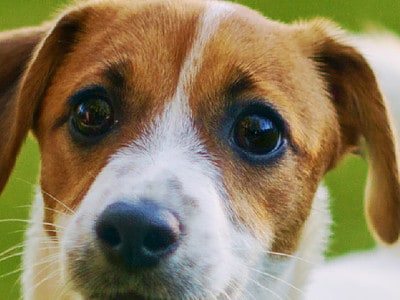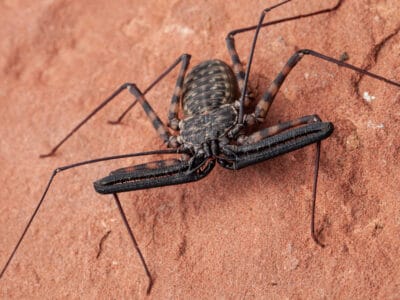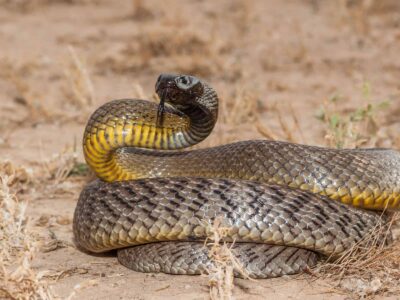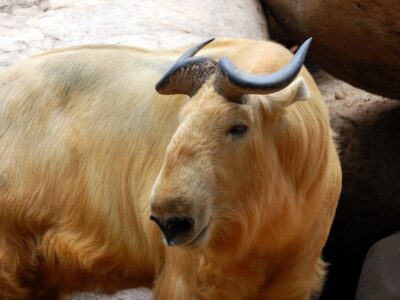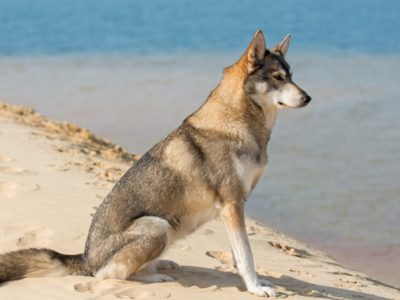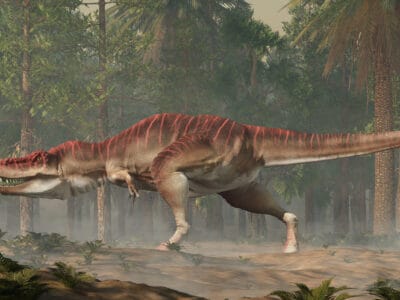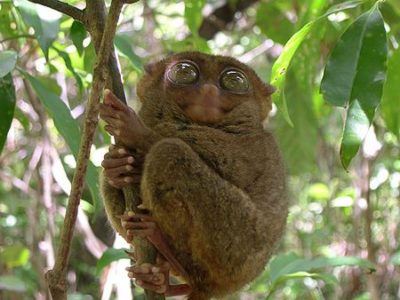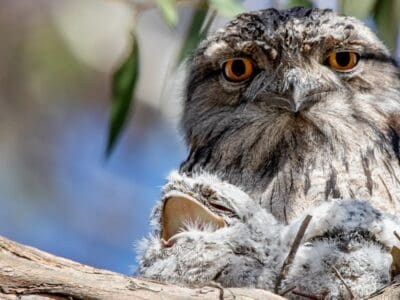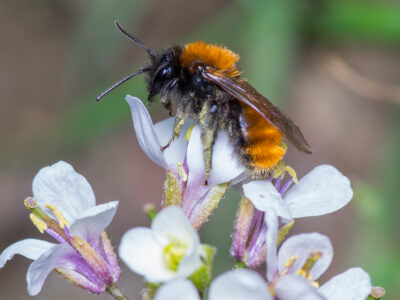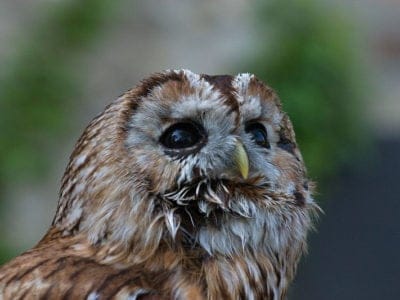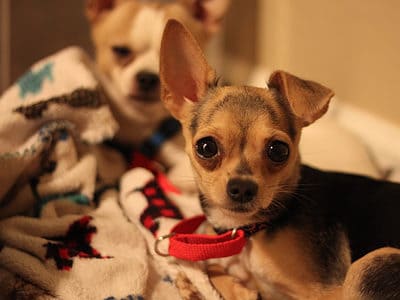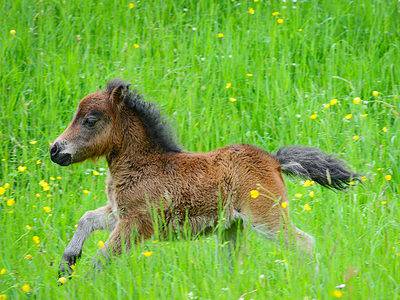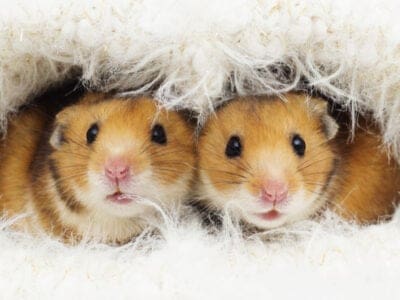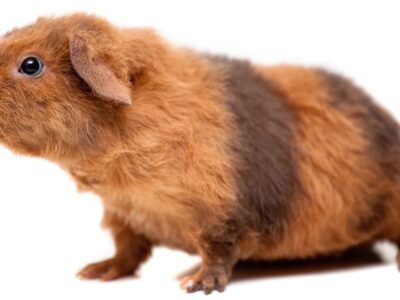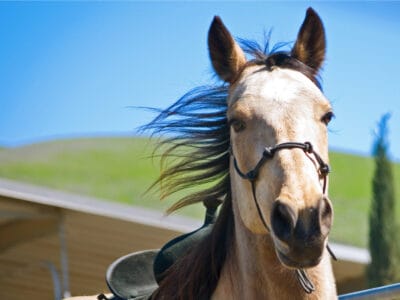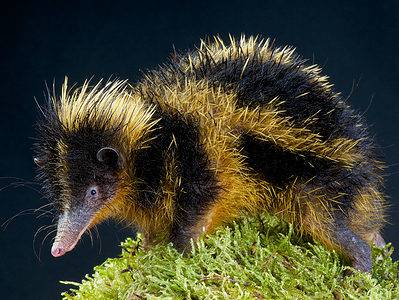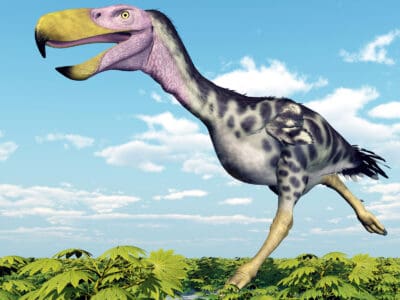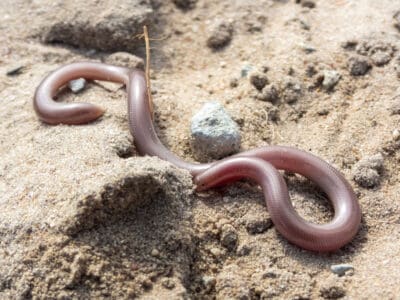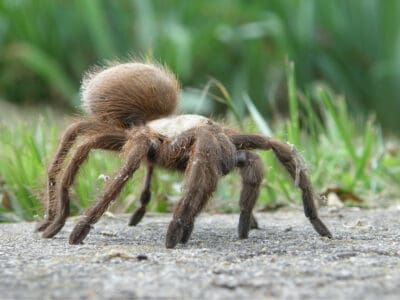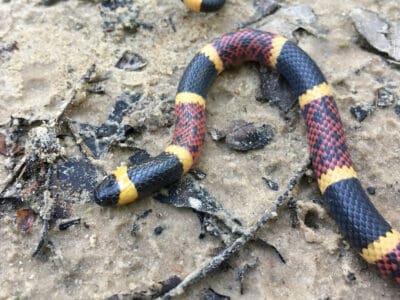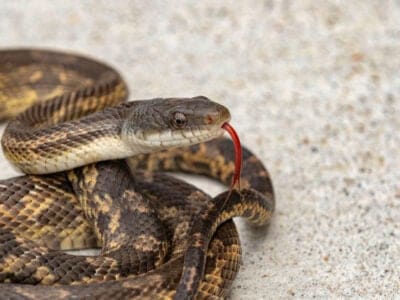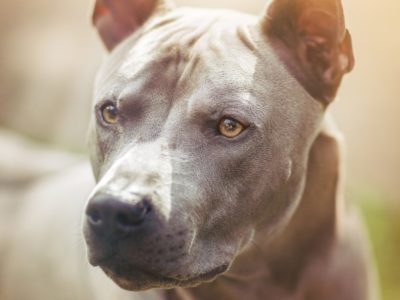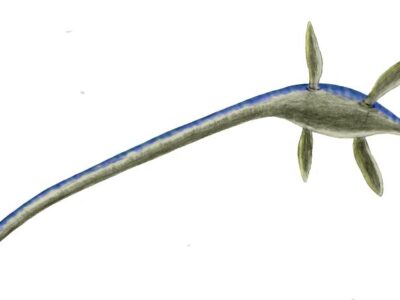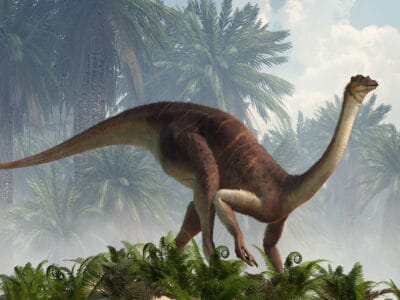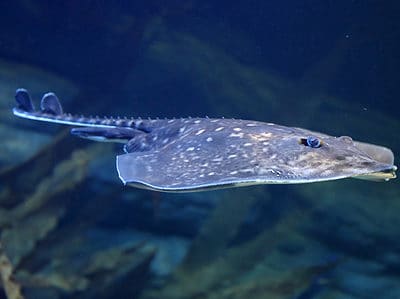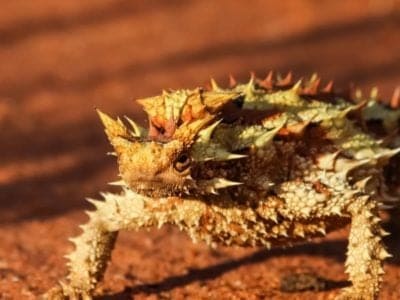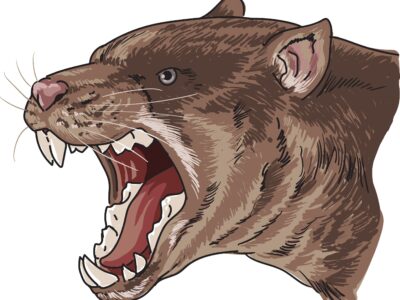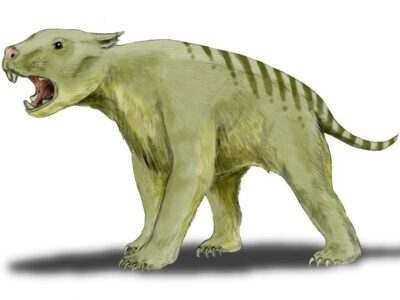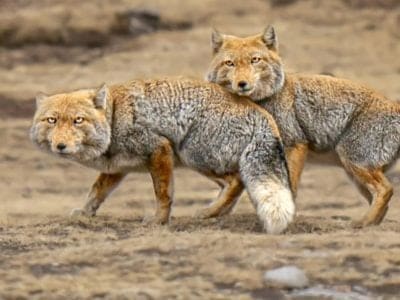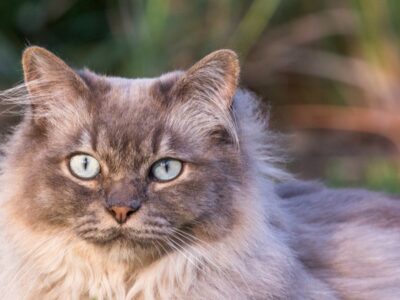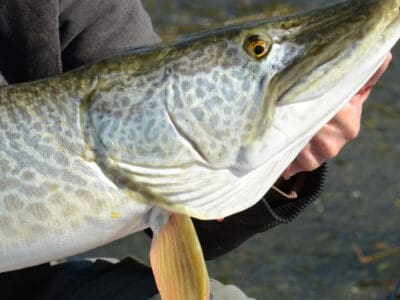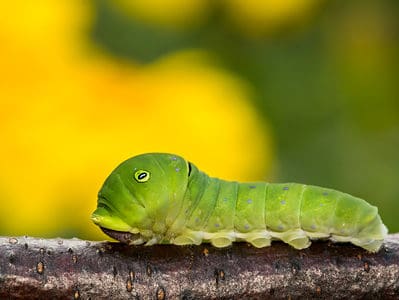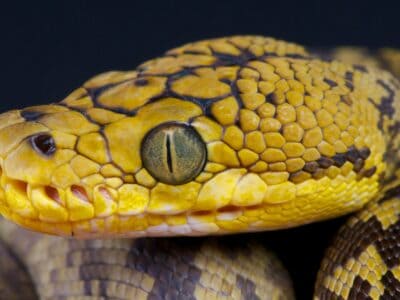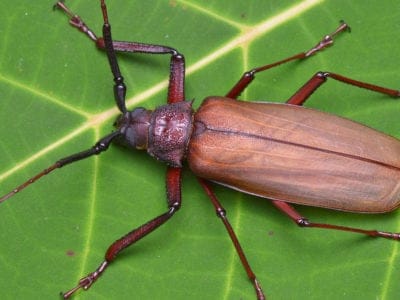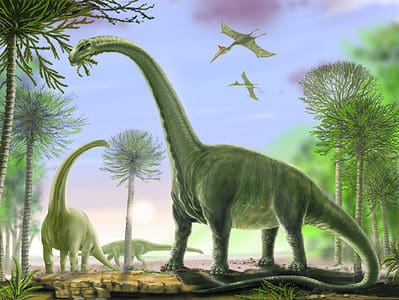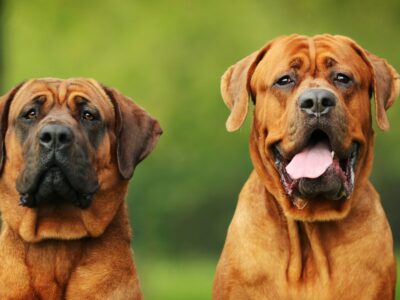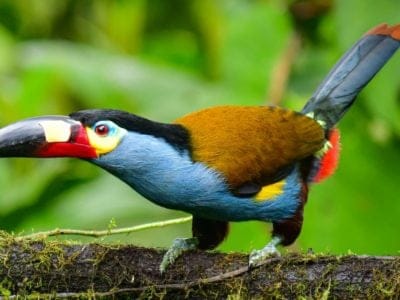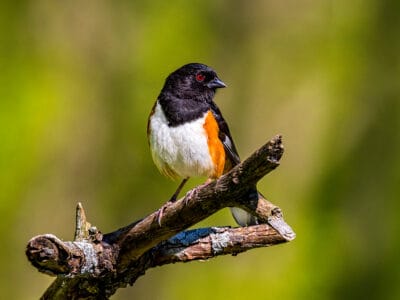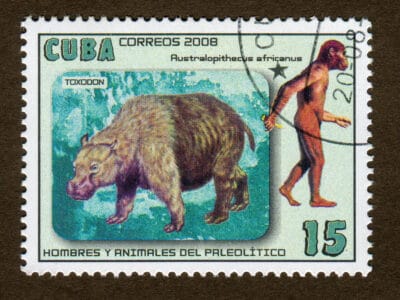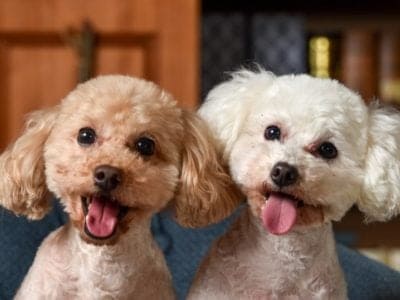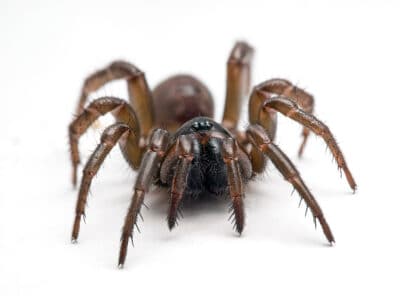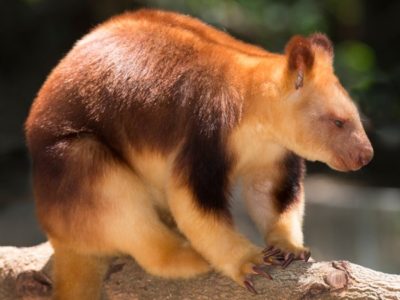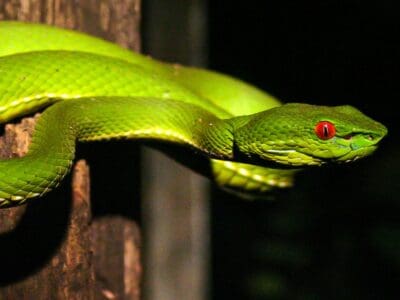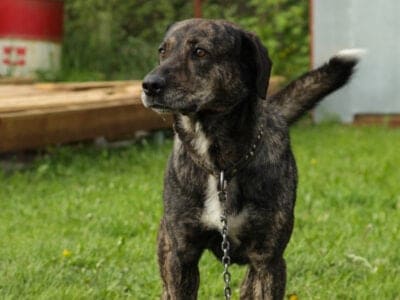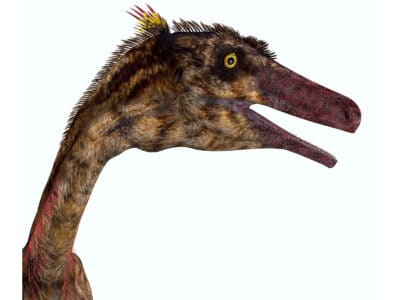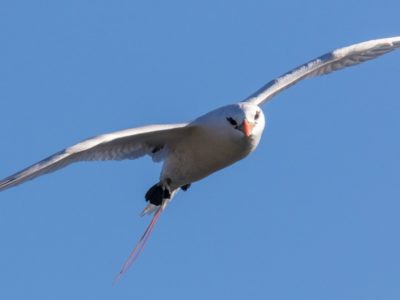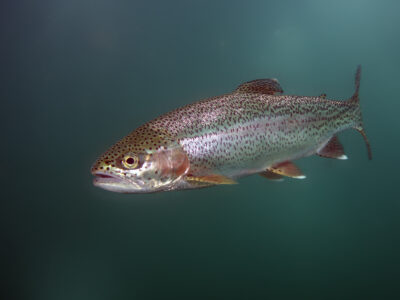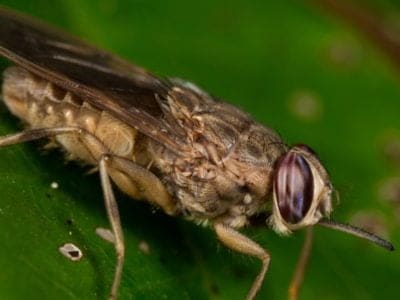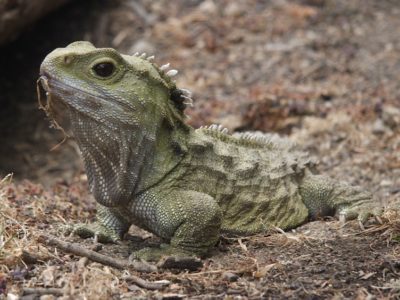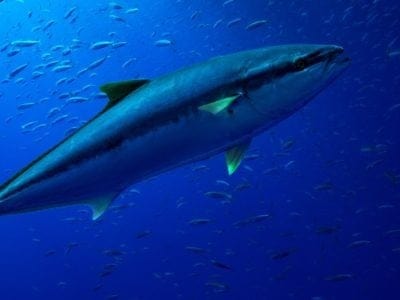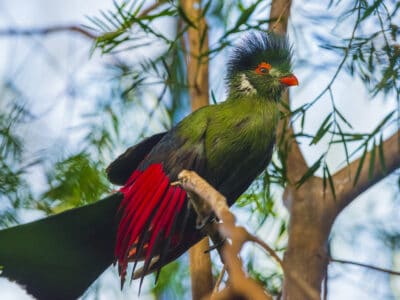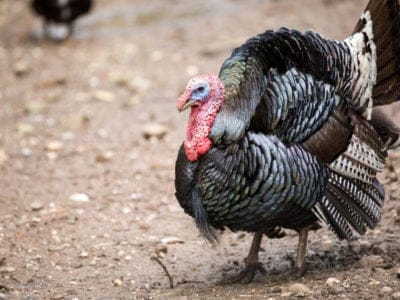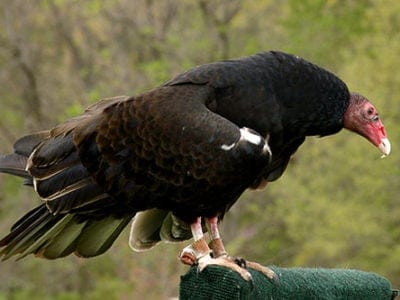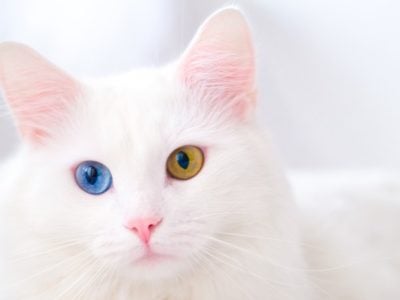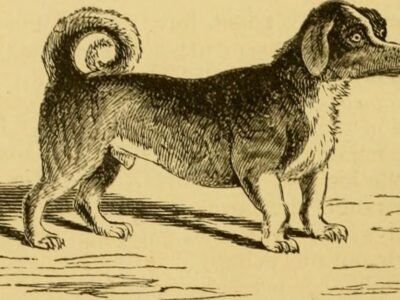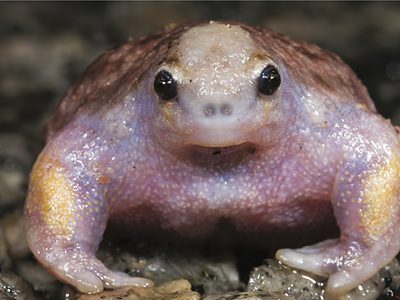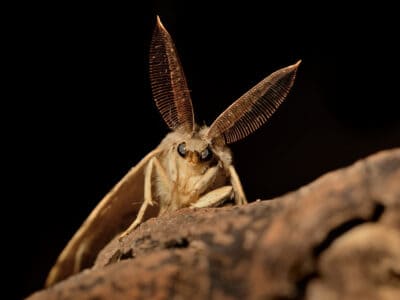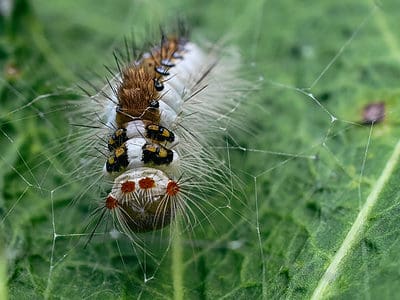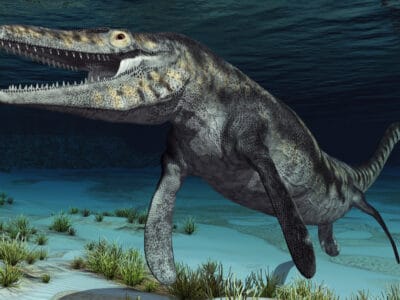Read below for information on 133 different animals that start with the letter T, from the small tang fish to turkeys. The most popular animal that starts with the letter T is the tiger, the largest cat species in the world. The least popular T animal is the tropicbird, so named for its habitat in tropical cliffs. Interesting facts about letter T name animals include:
- Certain species of tortoises can live to be over 150 years old
- The tasmanian devil is only found on one island (Tasmania) in the world
- Weighing up to 1,400lbs, the tiger shark is the largest shark species in the world
Jump to any letter
Alphabetical List of Animals That Start with T
- Taco Terrier
- Tailless Whip Scorpion
- Taimen Fish
- Taipan
- Takin
- Tamarin
- Tamaskan
- Tang
- Tangerine Leopard Gecko
- Tapanuli Orangutan
- Tapir
- Tarantula
- Tarantula Hawk
- Tarbosaurus
- Tarpon
- Tarsier
- Tasmanian Devil
- Tasmanian Tiger
- Tasmanian Tiger Snake
- Tawny Frogmouth
- Tawny Mining Bee
- Tawny Owl
- Teacup Chihuahua
- Teacup Maltese
- Teacup Miniature Horse
- Teacup Poodle
- Teddy Bear Hamster
- Teddy Guinea Pig
- Teddy Roosevelt Terrier
- Telescope Fish
- Ten-Lined June Beetle
- Tennessee Walking Horse
- Tenrec
- Tent Caterpillar
- Tentacled Snake
- Tenterfield Terrier
- Termite
- Terrier
- Terror Bird
- Tetra
- Texas Blind Snake
- Texas Brown Tarantula
- Texas Coral Snake
- Texas Garter Snake
- Texas Heeler
- Texas Indigo Snake
- Texas Night Snake
- Texas Rat Snake
- Texas Spiny Lizard
- Thai Ridgeback
- Thalassomedon
- Thanatosdrakon
- Therizinosaurus
- Theropod
- Thornback Ray
- Thorny Devil
- Thresher Shark
- Thrush
- Thylacoleo
- Thylacoleo carnifex
- Thylacosmilus
- Tibetan Fox
- Tibetan Mastiff
- Tibetan Spaniel
- Tibetan Terrier
- Tick
- Tiffany
- Tiger
- Tiger Beetle
- Tiger Moth
- Tiger Muskellunge (Muskie)
- Tiger Rattlesnake
- Tiger Salamander
- Tiger Shark
- Tiger snake
- Tiger Swallowtail
- Tiger Swallowtail Caterpillar
- Tiger Trout
- Tiktaalik
- Timber Rattlesnake (Canebrake Rattlesnake)
- Timor python
- Tire Track Eel
- Titan Beetle
- Titanoboa
- Titanosaur
- Toadfish
- Tokay Gecko
- Tomato Hornworm
- Torkie
- Tornjak
- Tortoise
- Tosa
- Toucan
- Towhee
- Toxodon
- Toy Fox Terrier
- Toy Poodle
- Transylvanian Hound
- Trapdoor spider
- Tree Cricket
- Tree Frog
- Tree Kangaroo
- Tree Snake
- Tree swallow
- Tree Viper (Bamboo Viper)
- Treecreeper
- Treehopper
- Treeing Tennessee Brindle
- Treeing Walker Coonhound
- Triggerfish
- Troodon
- Tropicbird
- Trout
- Tsetse Fly
- Tuatara
- Tufted Coquette
- Tufted Titmouse
- Tully Monster
- Tuna
- Tundra Swan
- Turaco
- Turkey
- Turkey Vulture
- Turkish Angora
- Turnspit
- Turtle Frog
- Turtles
- Tusoteuthis
- Tussock Moth
- Tussock Moth Caterpillar
- Twig Snake
- Tylosaurus
- Tyrannosaurus Rex
Animals that Start with T
Taco Terrier
- Kingdom
- Animalia
- Phylum
- Chordata
- Class
- Mammalia
- Order
- Carnivora
- Family
- Canidae
- Genus
- Canis
- Scientific Name
- Canis lupus
Fun Fact: Taco terriers are known by a variety of names, including the Chitoxy Toy and the Chiwoxy.
Despite their small size, taco terriers have incredibly sharp teeth and are great at chewing things to pieces. Be careful leaving loose shoes and other soft items out where your terrier can get to them. The popular taco terrier is a designer Terrier breed created by crossing a toy fox terrier with a chihuahua. The […] Read More
Tailless Whip Scorpion
- Kingdom
- Animalia
- Phylum
- Arthropoda
- Class
- Arachnida
- Order
- Amblypygi
Fun Fact: The average lifespan of these strange creatures is 5 to 10 years; however, tailless whip scorpions have been known to live up to a whopping 15 years in captivity!
Tailles whip scorpions are also known as whip spiders and fall under an ancient order of Amblypygi. This order consists of 5 families, 17 genera, and approximately 155 species. The most common species are Damon diadema and Damon variegatus. Despite their name, they are neither spiders nor scorpions. Instead, they are known as arthropods, a […] Read More
Taimen Fish
- Kingdom
- Animalia
- Phylum
- Chordata
- Class
- Actinopterygii
- Order
- Salmoniformes
- Family
- Salmonidae
- Genus
- Hucho
- Scientific Name
- Hucho Taimen
Fun Fact: The Taimen is considered one of the oldest species on earth, with fossilized remains dating back more than 40 million years!
Taimen fish are native to the rivers of Russia, Mongolia, and China. These regions span from China’s Amur River Pacific Drainages to far-western Europe’s upper Volga River Basin. Taimen fish are the first species of fish to be domesticated by humans that dates back to the Paleolithic era. According to archeological findings, Taimen fish were […] Read More
Taipan
- Kingdom
- Animalia
- Phylum
- Chordata
- Class
- Reptilia
- Order
- Squamata
- Family
- Elapidae
- Genus
- Oxyuranus
- Scientific Name
- Oxyuranus
Fun Fact: The Most Venomous Snakes On Earth
“Taipan is the Most Venomous Snakes On Earth” It’s true that the taipan has fantastically potent venom, but it also benefits humans by eating vermin such as rats and mice. Found only in Australia and New Guinea, taipans are long snakes that can move fast, whether to escape danger or deliver a fatal bite. Amazingly, […] Read More
Takin
- Kingdom
- Animalia
- Phylum
- Chordata
- Class
- Mammalia
- Order
- Artiodactyla
- Family
- Bovidae
- Genus
- Budorcas
- Scientific Name
- Budorcas taxicolor
Fun Fact: The takin can leap some 6 feet through the air
The takin, also known as the cattle chamois or the gnu goat, looks like a cross between a cow, an antelope, and a goat. But don’t be fooled by its strange appearance. This species is supremely well adapted for some of the most rugged terrains on the planet. It actually shares a close ancestry with […] Read More
Tamarin
- Kingdom
- Animalia
- Phylum
- Chordata
- Class
- Mammalia
- Order
- Primates
- Family
- Callitrichidae
Fun Fact: These tiny yet intelligent monkeys often give birth to fraternal twins.
Tamarins are small New World monkeys from the family Callitrichidae. You can find tamarins from southern Central America throughout central South America, particularly in the Amazon Basin. They live in family groups and spend most of their lives in trees which provide them with food and cover. Many tamarin species are threatened by habitat loss […] Read More
Tamaskan
- Kingdom
- Animalia
- Phylum
- Chordata
- Class
- Mammalia
- Order
- Carnivora
- Family
- Canidae
- Genus
- Canis
- Scientific Name
- Canis lupus
Fun Fact:
While this breed may look like a wolf, Tamaskans are very tame and gentle with their owners. A group of British breeders undertook a project in the 1980s to develop a new dog breed with a wolf-like appearance. The Tamaskan was one of the results of that effort, which combined German Shepherds, Siberian Huskies, Alaskan […] Read More
Tang
- Kingdom
- Animalia
- Phylum
- Chordata
- Class
- Actinopterygii
- Order
- Perciformes
- Family
- Acanthuridae
Fun Fact: Found around shallow coral reefs!
The Tang fish is highly sought after by aquarium owners all over the world. With its brightly colored body and stark patterns, the tang makes for an incredibly vivid display in the home. It is well-adapted for its natural habitat in the coral reefs. This can make it a little difficult to keep in an […] Read More
Tangerine Leopard Gecko
- Kingdom
- Animalia
- Phylum
- Chordata
- Class
- Reptilia
- Order
- Squamata
- Family
- Eublepharidae
- Genus
- Eublepharis
- Scientific Name
- Eublepharis macularius
Fun Fact: Unlike most geckos, tangerine leopard geckos have movable eyelids.
“The tangerine leopard gecko is one of the most popular pet leopard gecko morphs.“ These popular lizards are small, cute, and do really silly things that endear them to their owners. Leopard geckos are considered one of the first pet lizards and were originally exported as pets in the 1960s. Incredible Tangerine Leopard Gecko Facts […] Read More
Tapanuli Orangutan
- Kingdom
- Animalia
- Phylum
- Chordata
- Class
- Mammalia
- Order
- Primates
- Family
- Hominidae
- Genus
- Pongo
- Scientific Name
- Pongo tapanuliensis
Fun Fact: Inhabits an isolated mountain range in northwestern Sumatra!
Tapanuli Orangutan Classification and Evolution The Tapanuli orangutan is one of just three orangutan species in the world (the other two being the Bornean orangutan and the Sumatran orangutan). Only named as a distinct species in science in 2017, the Tapanuli orangutan is the first great ape to have been discovered since the bonobo nearly […] Read More
Tapir
- Kingdom
- Animalia
- Phylum
- Chordata
- Class
- Mammalia
- Order
- Perissodactyla
- Family
- Tapiridae
- Genus
- Tapirus
Fun Fact: Most closely related to horses and rhinos!
Amazingly, the roots of the modern Tapir species can be traced all the way back to the Eocene Epoch, which lasted from 56 to 33.9 million years ago. These early Tapirs were smaller than their modern counterparts and did not have an elongated nose or upper lip. These species weighed up to 400 pounds and […] Read More
Tarantula
- Kingdom
- Animalia
- Phylum
- Arthropoda
- Class
- Arachnida
- Order
- Araneae
- Family
- Theraphosidae
Fun Fact: More than 1000 species of tarantulas have been identified all around the world!
More than 1,000 species of tarantulas have been identified all around the world! Tarantulas are among the largest spiders in the world. Many people fear them due to their size and their hairy appearance. However, most tarantulas pose little to no danger to humans. They are reclusive creatures and would much rather avoid confronting a […] Read More
Tarantula Hawk
- Kingdom
- Animalia
- Phylum
- Arthropoda
- Class
- Insecta
- Order
- Hymenoptera
- Family
- Pompilidae
- Genus
- Pepsis
- Scientific Name
- Pepsis albocincta
Fun Fact: Tarantula hawks are excellent pollinators, especially for milkweed.
“Not a bird, but a wasp with a powerful sting.” The tarantula hawk wasp gets its name because it hunts, rather like a bird of prey. In this case, the prey is a tarantula or a large and well-fed spider. The wasp doesn’t eat the tarantula but paralyzes it, drags it to its burrow, and […] Read More
Tarbosaurus
- Kingdom
- Animalia
- Phylum
- Chordata
- Class
- Reptilia
- Order
- Saurischia
- Family
- Tyrannosauridae
- Genus
- Tarbosaurus
- Scientific Name
- Tarbosaurus bataar
Fun Fact: Tarbosaurus‘ name “bataar” is a mispelling of the Mongolian word “baatar,” which means “hero.”
The Tarbosaurus bataar, also known as the Alarming Lizard, was found in China and Mongolia. It is native to the continent of Asia and is often mistaken for the Tyrannosaurus. Find out more about this ancient creature, including where it lived, its size, and more! Description & Size According to the fossil that was found […] Read More
Tarpon
- Kingdom
- Animalia
- Phylum
- Chordata
- Class
- Actinopterygii
- Order
- Elopiformes
- Family
- Megalopidae
- Genus
- Megalops
Fun Fact: Its genus dates back to the Cretaceous period – 113 million years ago
The Tarpon is a popular game fish that is prized not for its flesh but for its vigor upon being captured. The tarpon fish, also known as the silver king, silverfish, silver sides, and sabalo, is a versatile fish that lives mostly in oceans but also in freshwater areas, including rivers and marshes. Consisting of […] Read More
Tarsier
- Kingdom
- Animalia
- Phylum
- Chordata
- Class
- Mammalia
- Order
- Primates
- Family
- Tarsiidae
- Genus
- Tarsius
- Scientific Name
- Tarsius
Fun Fact: Each eye weighs more than their whole brain!
The Tarsier is one of the most unique primates on the planet. It is known to have the largest eyes of any mammal in relation to its body size. Each eye is actually heavier than its brain! 3 Interesting Facts: The Tarsier has an unusually long anklebone that enables it to jump distances more than […] Read More
Tasmanian Devil
- Kingdom
- Animalia
- Phylum
- Chordata
- Class
- Mammalia
- Order
- Dasyuromorphia
- Family
- Dasyuridae
- Genus
- Sarcophilus
- Scientific Name
- Sarcophilus harrisii
Fun Fact: Exclusively found on the island of Tasmania!
“Tasmanian Devils let out a sneeze to scare away animals that want to fight” A Tasmanian Devil is a marsupial. They are nocturnal animals, hunting for prey at night. These mammals are carnivores eating birds, insects, frogs, and carrion (dead animals). Tasmanian Devils live a solitary life. They can reach the age of around five […] Read More
Tasmanian Tiger
- Kingdom
- Animalia
- Phylum
- Chordata
- Class
- Mammalia
- Order
- Dasyuromorphia
- Family
- †Thylacinidae
- Genus
- †Thylacinus
- Scientific Name
- †Thylacinus cynocephalus
Fun Fact: The Tasmanian tiger could open its mouth almost 90 degrees.
One of the most fascinating animals to have existed, the Tasmanian tiger, Tasmanian wolf, or thylacine was extinct in the wild by the early 20th century and went extinct altogether in 1936. It looked like a dog with some tiger stripes but was neither a dog nor a tiger. Like so many other animals found […] Read More
Tasmanian Tiger Snake
- Kingdom
- Animalia
- Phylum
- Chordata
- Class
- Reptilia
- Order
- Squamata
- Family
- Elapidae
- Genus
- Notechis
- Scientific Name
- Notechis scutatus humphreysi
Fun Fact: The Tasmanian tiger snake gets its name from their banded skin, closely resembling a tiger's stripes.
Tasmanian tiger snakes get their name from the black and yellow crossbands on their bodies. However, not all tiger snakes have these markings. These snakes often occur near water sources like dams, creeks, lagoons, swamps, wetlands, and even drains. In addition, their large size, aggressive nature, and toxic venom make these snakes dangerous to humans. […] Read More
Tawny Frogmouth
- Kingdom
- Animalia
- Phylum
- Chordata
- Class
- Aves
- Order
- Caprimulgiformes
- Family
- Podargidae
- Genus
- Podargus
- Scientific Name
- Podargus strigoides
Fun Fact: The tawny frogmouth is a master of camouflage that can hide in plain sight!
The tawny frogmouth is a master of camouflage that can hide in plain sight! What superpower would you choose, silent flight or invisibility? Night vision or super hearing? The tawny frogmouth says, “All of the above, please!” This master of camouflage hides in plain sight during the day and hunts at night, gobbling up creatures […] Read More
Tawny Mining Bee
- Kingdom
- Animalia
- Phylum
- Arthropoda
- Class
- Insecta
- Order
- Hymenoptera
- Family
- Andrenidae
- Genus
- Andrena
- Scientific Name
- Andrena fulva
Fun Fact: N/A
As the warming rays of the sun climb higher in the morning sky a tiny but mighty creature emerges from its underground lair. Meet Andrena fulva, the tawny mining bee. Tawny mining bees are formidable pollinators and expert diggers that play a crucial role in maintaining the balance of nature. With its sensational furry coat […] Read More
Tawny Owl
- Kingdom
- Animalia
- Phylum
- Chordata
- Class
- Aves
- Order
- Strigiformes
- Family
- Strigidae
- Genus
- Strix
- Scientific Name
- Strix aluco
Fun Fact: The most widespread owl in Europe!
“Tawnies are by far the most common owl species in the UK, with an estimated population of 50,000 pairs.” A species of wood owl, tawny owls are highly territorial and about the size of a wood-pigeon. These medium-sized owls live across Europe and in some parts of Asia, but you will mainly find them in […] Read More
Teacup Chihuahua
- Kingdom
- Animalia
- Phylum
- Chordata
- Class
- Mammalia
- Order
- Carnivora
- Family
- Canidae
- Genus
- Canis
- Scientific Name
- Canis lupus
Fun Fact: Teacup Chihuahuas are not a separate breed but result from breeding the smallest pups from litters.
Chihuahuas are enthusiastic and friendly dogs that originated some time ago in Mexico. Though they are wary of strangers, they are loyal and loving dogs that deal well with children if they know them. Though the breed was rediscovered there in the 19th century, today’s dog does not entirely share the bloodlines of the dogs […] Read More
Teacup Maltese
- Kingdom
- Animalia
- Phylum
- Chordata
- Class
- Mammalia
- Order
- Carnivora
- Family
- Canidae
- Genus
- Canis
- Scientific Name
- Canis lupus
Fun Fact: Greeks used to build tombs for their Maltese.
Introduction The Maltese has an ancient lineage. Though it is believed to originate in Malta, many believe it was introduced to Europe by the Phoenicians before the rise of Greece, somewhere before the 5th century BC. From that time forward, it became the must-have dog of historical civilizations, from ancient Greece to the Roman Empire […] Read More
Teacup Miniature Horse
- Kingdom
- Animalia
- Phylum
- Chordata
- Class
- Mammalia
- Order
- Perissodactyla
- Family
- Equidae
- Genus
- Equus ferus caballus
- Scientific Name
- Equus
Fun Fact: Female teacup minis become sexually mature between 2 and 5 years old, but breeders typically wait until their horse is 3 before letting her reproduce to prevent complications.
Teacup miniature horses make fantastic companion animals. These tiny equines were bred specifically to be miniature duplicates of fully-grown horses. While ponies are bulky, with thick necks, short legs, and fluffy manes and tails, teacup miniature horses have refined features. In addition, they are primarily kept as companions, but some people let children ride them. […] Read More
Teacup Poodle
- Kingdom
- Animalia
- Phylum
- Chordata
- Class
- Mammalia
- Order
- Carnivora
- Family
- Canidae
- Genus
- Canis
- Scientific Name
- Canis lupus
Fun Fact: The teacup poodle is the smallest poodle breed!
Introduction The teacup poodle is a designer/toy variety of the standard poodle that so many dog owners know and love. The origins of the poodle are shrouded in mystery, but it has been known for over 400 years in western Europe. When many think of the poodle, they think of France, but the AKC believes […] Read More
Teddy Bear Hamster
- Kingdom
- Animalia
- Phylum
- Chordata
- Class
- Mammalia
- Order
- Rodentia
- Family
- Cricetidae
- Genus
- Mesocricetus
- Scientific Name
- Mesocricetus auratus
Fun Fact: The oldest recorded teddy bear hamster was six and a half.
“A teddy bear hamster can stuff its cheek pouches with an amount of food equal to 20 percent of its body weight” The teddy bear hamster is also known as a long-haired Syrian hamster. These tiny mammals are herbivores eating grains, vegetables, and fruit. A teddy bear hamster’s tail is very short at about half […] Read More
Teddy Guinea Pig
- Kingdom
- Animalia
- Phylum
- Chordata
- Class
- Mammalia
- Order
- Rodentia
- Family
- Caviidae
- Genus
- Cavia
- Scientific Name
- Cavia porcellus
Fun Fact: Teddy guinea pigs resemble teddy bears, hence their name.
Teddy guinea pigs resemble teddy bears, hence their name. Facts Teddy guinea pigs have denser fur than any other guinea pig breed.Their features make them closely resemble teddy bears, hence their common name.Teddy guinea pigs are very vocal animals. They spend time chattering with themselves in their cages, squeaking when they see their owner or […] Read More
Teddy Roosevelt Terrier
- Kingdom
- Animalia
- Phylum
- Chordata
- Class
- Mammalia
- Order
- Carnivora
- Family
- Canidae
- Genus
- Canis
- Scientific Name
- Canis lupus
Fun Fact: The breed was named in President Theodore Roosevelt's honor when it was officially recognized in 1999.
Teddy Roosevelt Terriers are often called “Teddies.” The Teddy Roosevelt Terrier is an American ratting dog that shares its personality traits, coat colors, and breed origin with the rat terrier. The dogs have a low-set, small to mid-sized body and muscular frame with a coat that can be many combinations of colors. However, their colors […] Read More
Telescope Fish
- Kingdom
- Animalia
- Phylum
- Chordata
- Class
- Actinopterygii
- Order
- Aulopiformes
- Family
- Giganturidae
- Genus
- Gigantura
Fun Fact: Swallows food, much of it larger than them, whole
The telescope fish is a striking, colorful creature that exists in deep-sea tropical and subtropical ecosystems. The telescope fish exists in depths of three-quarter miles to 1.3 miles down. Living deep below surfaces and away from natural light, these fish live in dark waters. To compensate, Mother Nature gave the telescope fish tubular eyes that […] Read More
Ten-Lined June Beetle
- Kingdom
- Animalia
- Phylum
- Arthropoda
- Class
- Insecta
- Order
- Coleoptera
- Family
- Scarabaeidae
- Genus
- Polyphylla
- Scientific Name
- Polyphylla decemlineata
Fun Fact: These beetles can take up to two years to complete one generation. In fact, larvae can develop in soil for up to 4 years!
Ten-lined June beetles are members of the Scarabaeidae family and fall into the class Insecta. They occur all over the globe and are known for their unique wings, which are covered in linear patterns. They also go by the name watermelon beetles and have very poor eyesight, which is why they are so attracted to […] Read More
Tennessee Walking Horse
- Kingdom
- Animalia
- Phylum
- Chordata
- Class
- Mammalia
- Order
- Perissodactyla
- Family
- Equidae
- Genus
- Equus
- Scientific Name
- Equus ferus
Fun Fact: There's a national celebration of Tennessee Walkers each year
“The Tennessee Walking Horse is known for its unique running walk.” Tennessee Walking horses, aka Tennessee Walkers, are friendly, docile horses with three types of gaits. They have long, elegant necks and can be dark brown, black, white, palomino, or gray in color. Tennessee Walkers are popular as both show horses and horses ridden for […] Read More
Tenrec
- Kingdom
- Animalia
- Phylum
- Chordata
- Class
- Mammalia
- Order
- Afrosoricida
- Family
- Tenrecidae
- Scientific Name
- Tenrecidae
Fun Fact: Hedgeho-like nocturnal insectivore
While the Madagascar tenrec closely resembles a hedgehog, they are not related to each other. Tenrec Summary Tenrecs are small, insectivorous mammals that are only native to Madagascar. They are closely related to hedgehogs and have a similar appearance, although they sometimes lack the spines that hedgehogs have. They are nocturnal animals and spend most […] Read More
Tent Caterpillar
- Kingdom
- Animalia
- Phylum
- Arthropoda
- Class
- Insecta
- Order
- Lepidoptera
- Family
- Lasiocampidae
- Genus
- Malacosoma
Fun Fact: N/A
Tent caterpillars are the larval stage of certain species of moths. They are called tent caterpillars because they build silken nests or webs in the branches of the trees and shrubs on which they feed. Tent caterpillars can cause significant damage to trees and are considered a pest species. There are 26 separate species. North […] Read More
Tentacled Snake
- Kingdom
- Animalia
- Phylum
- Chordata
- Class
- Reptilia
- Order
- Squamata
- Family
- Colubridae
- Genus
- Erpeton
- Scientific Name
- Erpeton tentaculatum
Fun Fact: Their tentacles have nerves that attach directly into the area of the brain that processes visual information.
Tentacled snakes are unique aquatic snakes that live in Peninsular Southeast Asia in Cambodia, Vietnam, and Thailand. These small snakes are fish eaters that only rarely eat other creatures like frogs or softshell crabs. They may only come out of the water to burrow in the mud if the water they live in dries up […] Read More
Tenterfield Terrier
- Kingdom
- Animalia
- Phylum
- Chordata
- Class
- Mammalia
- Order
- Carnivora
- Family
- Canidae
- Genus
- Canis
- Scientific Name
- Canis lupus
Fun Fact: These terriers have quick minds and fast feet making them excellent for agility competitions.
Tenterfield Terriers are smart and move very quickly which is why they are a popular choice for agility competitions. The Tenterfield Terrier is a smart, active, and friendly dog. This breed is a relative of the miniature fox terrier that originated in England in the mid-1800s. Early settlers traveled with these terriers to Australia where […] Read More
Termite
- Kingdom
- Animalia
- Phylum
- Arthropoda
- Class
- Insecta
- Order
- Isoptera
- Scientific Name
- Isoptera
Fun Fact: Their mounds can be up to 9 meters tall!
Termites never sleep! Often referred to as silent destroyers, termites are responsible for an estimated $5 billion in property damage each year. The insects have six legs and large heads compared to the size of their bodies. Termites are typically white or a light yellow color. The insect species live in colonies with a queen, […] Read More
Terrier
- Kingdom
- Animalia
- Phylum
- Chordata
- Class
- Mammalia
- Order
- Carnivora
- Family
- Canidae
- Genus
- Canis
- Scientific Name
- Canis lupus
Fun Fact: Terriers were once the greatest dogs in the world.
The Terrier is not a dog breed in and of itself, but a dog group of breeds that share common features. They range from small to large sizes with coats that range from short and wiry to long and smooth and personalities that are fearless, lively, protective, loyal, intelligent, and playful. Terriers are bred to […] Read More
Terror Bird
- Kingdom
- Animalia
Fun Fact: Though terror birds were flightless, their wings featured an unusual sharp claw which they could use as a weapon.
The aptly named Terror Bird was a feathered predator that ruled the forests and plains of South America shortly after the dinosaurs died out. The giant flightless bird was characterized by its large weapon-like beak that has been likened to a pick-ax. Despite its huge size, the terror bird was faster than a modern horse. […] Read More
Tetra
- Kingdom
- Animalia
- Phylum
- Chordata
- Class
- Actinopterygii
- Order
- Characiformes
- Family
- Characidae
- Genus
- Paracheirodon
- Scientific Name
- Paracheirodon Axelrodi
Fun Fact: Native to the freshwater streams of South America!
Tetra is a general name for tropical freshwater fish of the Characidae family. They are popular because they are peaceful species that can live with many other types of aquarium features. Aquarium enthusiasts also love them because they are easy to maintain, particularly the ember tetra. They come in many bright colors, like yellow, cardinal, […] Read More
Texas Blind Snake
- Kingdom
- Animalia
- Phylum
- Chordata
- Class
- Reptilia
- Order
- Squamata
- Family
- Leptotyphopidae
- Genus
- Rena
- Scientific Name
- Rena dulcis
Fun Fact: These snakes grow to just 11 inches long
“These snakes grow to just 11 inches long.” The Texas blind snake is sometimes called a Texas slender blind snake or a Texas thread snake. These are fitting names for a snake with a very narrow body that measures just four to eleven inches in length. The diet of this snake includes insect larvae, ants, […] Read More
Texas Brown Tarantula
- Kingdom
- Animalia
- Phylum
- Arthropoda
- Class
- Arachnida
- Order
- Araneae
- Family
- Theraphosidae
- Genus
- Aphonopelma
- Scientific Name
- Aphonopelma hentzi
Fun Fact: You may see a mass migration of tarantulas in late summer or fall.
“The Texas brown tarantula is a classic big hairy spider!” Texas browns are one of the most common tarantulas in the US and are often called Missouri tarantulas or Oklahoma browns. Their bodies and legs are covered in brown hairs that give them a furry look. They have eight long segmented legs with two additional […] Read More
Texas Coral Snake
- Kingdom
- Animalia
- Phylum
- Chordata
- Class
- Reptilia
- Order
- Squamata
- Family
- Elapidae
- Genus
- Micrurus
- Scientific Name
- Micrurus tener
Fun Fact: Texas coral snakes have the second most powerful venom in the world
Texas coral snakes have the second most powerful venom in the world. The nocturnal Texas coral snake is notable for its bands of black, yellow, and red. It has a diet consisting mostly of earth snakes and skinks. During the day, Texas coral snakes spend a lot of time underground or hiding under piles of […] Read More
Texas Garter Snake
- Kingdom
- Animalia
- Phylum
- Chordata
- Class
- Reptilia
- Order
- Squamata
- Family
- Colubridae
- Genus
- Thamnophis
- Scientific Name
- Thamnophis sirtalis annectens
Fun Fact: These snakes defensively emit a foul-smelling musk if you handle them!
Texas garter snakes provide helpful pest control for gardens and residential areas. The Texas garter snake is one of 13 subspecies of the common garter snake native to North America. This subspecies is found in central Texas, Kansas, and sometimes South Dakota. They are not venomous to humans, yet have enough venom in their saliva […] Read More
Texas Heeler
- Kingdom
- Animalia
- Phylum
- Chordata
- Class
- Mammalia
- Order
- Carnivora
- Family
- Canidae
- Genus
- Canis
- Scientific Name
- Canis lupus
Fun Fact: Though they are loyal to their family, these dogs can be shy around strangers.
Texas Heelers are happiest when working, so they make good service dogs. Breed an Australian Shepherd and an Australian cattle dog and you have a Texas Heeler. Although it’s uncertain when this crossbreed originated, breeders in Texas created this type of heeler, and it was first registered in 1970. Breeders were looking for a dog […] Read More
Texas Indigo Snake
- Kingdom
- Animalia
- Phylum
- Chordata
- Class
- Reptilia
- Order
- Squamata
- Family
- Colubridae
- Genus
- Drymarchon
- Scientific Name
- Drymarchon melanurus erebennus
Fun Fact: Texas Indigo Snakes are known for chasing down, overpowering, and eating rattlesnakes.
“If it’s a Texas Indigo snake, let it go,” is a popular adage among Texas ranchers and farmers. They’re very popular in southern/central Texas where they primarily live. Texas indigo snakes are known for actively hunting and eating rattlesnakes. Diurnal by nature, they spend their nights in the burrows that other animals abandon. These snakes […] Read More
Texas Night Snake
- Kingdom
- Animalia
- Phylum
- Chordata
- Class
- Reptilia
- Order
- Squamata
- Family
- Colubridae
- Genus
- Hypsiglena
- Scientific Name
- Hypsiglena jani
Fun Fact: The Texas night snake has vertical pupils to help it see better at night.
The Texas night snake has vertical pupils to help it see better at night. The Texas night snake, also known just as often as the Chihuahuan night snake, spends most of the day hiding under rocks and logs. It comes out at night to hunt for its prey. This snake’s natural range maps across some […] Read More
Texas Rat Snake
- Kingdom
- Animalia
- Phylum
- Chordata
- Class
- Reptilia
- Order
- Squamata
- Family
- Colubridae
- Genus
- Pantherophis
- Scientific Name
- Pantherophis obsoletus lindheimeri
Fun Fact: The Texas rat snake is one of the most common subspecies of the western rat snake in the wild.
The Texas rat snake is one of the most common subspecies of the western rat snake in the wild. If you live anywhere in the south-central United States, then you may see these large snakes out in the grass or somewhere near you’re home but don’t panic. They’re generally not dangerous to people and can […] Read More
Texas Spiny Lizard
- Kingdom
- Animalia
- Phylum
- Chordata
- Class
- Reptilia
- Order
- Squamata
- Family
- Phrynosomatidae
- Genus
- Sceloporus
- Scientific Name
- Sceloporus olivaceous
Fun Fact: They hold push-up competitions!
The Texas spiny lizard is a small reptile native to Mexico and the south-central region of the United States. It prefers to live in mesquite trees and lowland areas that have heavy ground leaf cover. The spiny lizard is a common visitor to backyards and fences in Oklahoma, Texas, and Arizona. With a slender body […] Read More
Thai Ridgeback
- Kingdom
- Animalia
- Phylum
- Chordata
- Class
- Mammalia
- Order
- Carnivora
- Family
- Canidae
- Genus
- Canis
- Scientific Name
- Canis lupus
Fun Fact: In their native Thailand, Thai Ridgebacks were used to hunt cobras.
In their native Thailand, Thai Ridgebacks were used to hunt cobras Thai Ridgebacks have only been domesticated for the past 350 years or so. Before that, they were free-range dogs, roaming southeastern Asia in packs and easily identifiable by their wedge-shaped heads, pointed muzzles, erect ears, pigmented tongues, and curved tails. The breed is still […] Read More
Thalassomedon
- Kingdom
- Animalia
- Phylum
- Chordata
- Class
- Reptilia
- Order
- Plesiosauria
- Family
- Elasmosauridae
- Genus
- Thalassomedon
- Scientific Name
- Thalassomedon haningtoni
Fun Fact: The length of the Thalassomedon's neck was up to half its body length
Thalassomedon is a genus of marine reptiles that lived in North America during the Late Cretaceous period. This giant creature belongs to an order of marine reptiles known as the plesiosaurs, characterized by their extremely long necks. Its closest relative is Elasmosaurus, another long-necked plesiosaur. Both reptiles belong to the family Elasmosauridae. Thalassomedon is known […] Read More
Thanatosdrakon
- Kingdom
- Animalia
- Phylum
- Chordata
- Class
- Reptilia
- Order
- Pterosauria
- Family
- Azhdarchidae
- Genus
- Thanatosdrakon
- Scientific Name
- Thanatosdrakon amaru
Fun Fact: Thanatosdrakon was one of the largest pterosaurs that lived in South America.
Thanatosdrakon (dragon of death) is a newly identified genus of pterosaur reptiles that lived in South America. The flying reptile lived during the Late Cretaceous about 86 million years ago. It is the oldest member of the Quetzalcoatlinae clade of reptiles to be discovered so far. The only species of this genus is Thanatosdrakon amaru. […] Read More
Therizinosaurus
- Kingdom
- Animalia
- Phylum
- Chordata
- Order
- Dinosauria
- Family
- Therizinosauridae
- Genus
- Therizinosaurus
- Scientific Name
- Therizinosaurus cheloniformis
Fun Fact: Longest claws of any terrestrial animal in history
Therizinosaurus is a genus of large, herbivorous dinosaurs from the Late Cretaceous period. The genus contains a single species, Therizinosaurus cheloniformis. Like all therizinosaurids, Therizinosaurus featured huge claw bones that were likely used to grasp and pull vegetation or as a form of defense. While originally thought to be related to ancient turtles, most experts […] Read More
Theropod
- Kingdom
- Animalia
- Phylum
- Chordata
- Class
- Amniota
- Order
- Dinosauria
- Family
- Saurischia
- Genus
- Esaurischia
- Scientific Name
- Theropoda
Fun Fact: Some theropods had feathers and may have been ancestors of modern birds.
Interesting Fact “Some theropods had feathers and may have been ancestors of modern birds.” Theropod Facts Theropods were a successful and widespread species. Their fossil remains are found on every continent.Many theropods had bird-like features, including feathers. These may have been used for insulation, courtship displays, or for some species possibly even flight.The theropods had […] Read More
Thornback Ray
- Kingdom
- Animalia
- Phylum
- Chordata
- Class
- Chondrichthyes
- Order
- Rajiformes
- Family
- Rajidae
- Genus
- Raja
- Scientific Name
- Raja clavata
Fun Fact: The skate with the biggest spines!
Thornback Ray Summary The thornback ray is a cartilaginous fish preferring to dwell on sea floors either in deeper water or along the coast. Its alternate name, the thornback skate, is more accurate given that this fish is actually a skate, not a ray. It lives in the Atlantic and Indian Oceans, mostly along European […] Read More
Thorny Devil
- Kingdom
- Animalia
- Phylum
- Chordata
- Class
- Reptilia
- Order
- Squamata
- Family
- Agamidae
- Genus
- Moloch
- Scientific Name
- Moloch horridus
Fun Fact: Found only on mainland Australia!
The thorny devil is covered in thorny spikes that make it look like a miniature dragon. A small lizard native to Australia, the thorny devil is known by various other names like a thorny dragon, moloch, and mountain devil. It’s mainly active during the day and can change colors to blend into its environment. As […] Read More
Thresher Shark
- Kingdom
- Animalia
- Phylum
- Chordata
- Class
- Chondrichthyes
- Order
- Lamniformes
- Family
- Alopiidae
- Genus
- Alopias
Fun Fact: Thresher Sharks have a distinctive, thresher-like tail.
Thresher sharks are a larger group of sharks found in all temperate and tropical oceans worldwide. This family contains a single genus and three modern-day species. Plus, all species in this family are vulnerable to extinction. 5 Thresher Shark Facts Tail weapon: These sharks use their tail to herd fish, stun them, and kill them. […] Read More
Thrush
- Kingdom
- Animalia
- Phylum
- Chordata
- Class
- Aves
- Order
- Passeriformes
- Family
- Turdidae
Fun Fact: The American robin is called the robin because its red breast reminded European settlers of the robin back in the old country.
The Thrush is called “Heralds of spring” Thrushes are smallish to medium-sized passerines or songbirds. They have a stocky build and large eyes, sometimes with rings around them. Thrushes are found all over the world and though most of them have rather drab plumage, they are known for the bluish color of their eggs and […] Read More
Thylacoleo
- Kingdom
- Animalia
- Phylum
- Chordata
- Class
- Mammalia
- Order
- Diprotodontia
- Family
- Thylacoleo
Fun Fact: Scientists have speculated that its bite force was equivalent to that of a 551 pound lion!
The thylacoleo was a genus of animals that contained the largest carnivore that ever lived in Australia and had the most powerful bite of any mammal, whether extant or extinct. Thylacoleo Description and Size Paleontologists believe that the largest species of this animal, T. carnifex stood around 30 inches tall at the shoulder and 59 […] Read More
Thylacoleo carnifex
- Kingdom
- Animalia
- Phylum
- Chordata
- Class
- Mammalia
- Order
- Diprotodontia
- Family
- Thylacoleonidae
- Genus
- Thylacoleo
- Scientific Name
- Thylacoleo carnifex
Fun Fact: Thylacoleo carnifex was the largest carnivorous mammal in Australia
Thylacoleo carnifex is an extinct species of carnivorous marsupials that once lived in Australia. This species existed from the Late Pliocene to the Late Pleistocene Epoch (from two million years ago until about 46,000 years ago). Despite its similarities with modern-day lions in size and appearance, Thylacoleo carnifex was a marsupial (a pouched mammal similar […] Read More
Thylacosmilus
- Kingdom
- Animalia
- Phylum
- Chordata
- Class
- Mammalia
- Order
- Sparassodonta
- Family
- Thylacosimilidae
- Genus
- Thylacosmilus
- Scientific Name
- Thylacosmilus atrox
Fun Fact: Thylacosmilus resembled saber-toothed cats, but they’re not related
Thylacosmilus is a genus of saber-toothed mammals that once lived in South America during the Late Miocene and Pliocene epochs. Like the saber-toothed cats of North America, this animal had prominent upper canines that grew out of its mouth. Interestingly, it was not related to the saber-toothed cats. In fact, it wasn’t a cat at […] Read More
Tibetan Fox
- Kingdom
- Animalia
- Phylum
- Chordata
- Class
- Mammalia
- Order
- Carnivora
- Family
- Canidae
- Genus
- Vulpes
- Scientific Name
- Vulpes ferrilata
Fun Fact: Tibetan foxes are not territorial and will share a hunting ground with other mated pairs.
“The Tibetan fox is a well-adapted animal that works with other predators to thrive in its natural plateau environment.” Tibetan foxes are some of the most distinguished members of the Vulpae family. These hardy plateau dwellers are chiseled out of necessary survival adaptations that make them the very best at hunting Plateau pikas and living […] Read More
Tibetan Mastiff
- Kingdom
- Animalia
- Phylum
- Chordata
- Class
- Mammalia
- Order
- Carnivora
- Family
- Canidae
- Genus
- Canis
- Scientific Name
- Canis lupus
Fun Fact: Originally bred in the Himalayan mountains!
Tibetan Mastiffs are a very old dog breed, and no one knows much about their history. They were used as guard and herd dogs by nomads in Tibet and were also watchdogs for Tibetan monasteries. While this breed has grown in popularity since the 1980s, they are still a less common dog breed. Based on […] Read More
Tibetan Spaniel
- Kingdom
- Animalia
- Phylum
- Chordata
- Class
- Mammalia
- Order
- Carnivora
- Family
- Canidae
- Genus
- Canis
- Scientific Name
- Canis lupus
Fun Fact: Originally bred to be a companion dog in Tibetan Buddhist lamaseries.
The Tibetan spaniel was originally bred in Asia to alert Buddhist monks of anyone who might approach their lamasery. Friendly and vocal, the Tibetan Spaniel loves to spend time with his family. This dog is sometimes called a “Tibby,” and the breed was originally bred for Buddhist monks, eventually reaching the US in the 1960s. […] Read More
Tibetan Terrier
- Kingdom
- Animalia
- Phylum
- Chordata
- Class
- Mammalia
- Order
- Carnivora
- Family
- Canidae
- Genus
- Canis
- Scientific Name
- Canis lupus
Fun Fact: Tibetan terriers have round, flat, “snow shoe” feet that evolved to give them traction on snowy Himalayan paths
Tibetan terriers have round, flat, “snow shoe” feet that evolved to give them traction on snowy Himalayan paths. A Tibetan terrier could easily be mistaken for a larger version of its cousin, the Lhasa apso. Like Lhasa apsos, Tibetan terriers have a long, historic association with Buddhist monasteries, and they also have that long front […] Read More
Tick
- Kingdom
- Animalia
- Phylum
- Arthropoda
- Class
- Arachnida
- Order
- Ixodida
Fun Fact: They inject hosts with a chemical that stops them from feeling the pain of the bite
The tick is a parasitic arachnid that feeds mainly on the blood of mammals and birds, but sometimes also on reptiles and amphibians. Dog and deer ticks are the most well-known types of these pests. Both can cause skin irritations and diseases such as Lyme disease and Rocky Mountain Spotted Fever. The American dog tick […] Read More
Tiffany
- Kingdom
- Animalia
- Phylum
- Chordata
- Class
- Mammalia
- Order
- Carnivora
- Family
- Felidae
- Genus
- Felis
- Scientific Name
- Felis catus
Fun Fact: Chantilly cats are a mixed-breed cross between a Burmese cat and a long-haired Asian cat.
The Cantilly-Tiffany is an attractive medium-sized cat with no extreme features. It sports a broad, wedge-shaped head, mid-sized ears with fur protruding from them, and a medium-length soft, silky coat that has the appearance of being long-haired. Its eyes are a blazing gold color. This breed originated in North America. Sadly, with the destruction by […] Read More
Tiger
- Kingdom
- Animalia
- Phylum
- Chordata
- Class
- Mammalia
- Order
- Carnivora
- Family
- Felidae
- Genus
- Panthera
- Scientific Name
- Panthera Tigris
Fun Fact: The largest feline in the world!
“No two tigers share the same pattern of stripes.” Tigers are animals that live in both warm and cold areas of Asia. They are carnivores that hunt for prey at night. These big cats are solitary, and territorial, and are one of the world’s apex predators. A Siberian tiger can weigh up to 675 pounds. […] Read More
Tiger Beetle
- Kingdom
- Animalia
- Phylum
- Arthropoda
- Class
- Insecta
- Order
- Coleoptera
- Family
- Carabidae
- Genus
- Cicindela
- Scientific Name
- Cicindelinae
Fun Fact: The adult tiger beetle is one of the fastest land insects in the world
“The oldest fossilized tiger beetles date back some 125 million years in a region that’s now called Inner Mongolia.” The tiger beetle is a diverse group of insects that spend most of their lives underground as larvae, waiting in ambush for prey. Upon reaching adulthood, they come up above ground to hunt and mate. The […] Read More
Tiger Moth
- Kingdom
- Animalia
- Phylum
- Arthropoda
- Class
- Insecta
- Order
- Lepidoptera
- Family
- Erebidae
- Genus
- Arctia
Fun Fact: The bright colors of this moth are a signal to predators that it has a terrible taste.
A tiger moth is most notable for its brightly colored wings. Their wing design can include a pattern of red, orange, green, white, and black. This moth’s caterpillar is sometimes called a woolly bear because of its furry body. These moths live in gardens, meadows, and woodlands. Their wingspan ranges from 1.5 to 2 inches. […] Read More
Tiger Muskellunge (Muskie)
- Kingdom
- Animalia
- Phylum
- Chordata
- Class
- Actinopterygii
- Order
- Esociformes
- Family
- Esocida
- Genus
- Esox
- Scientific Name
- Esox lucius x Esox masquinongy
Fun Fact: Massive carnivorous hybrid fish
One of the most coveted freshwater gamefish in the United States, tiger muskellunge — commonly called the tiger muskie — is notoriously difficult to reel in due to its size, strength, and erratic eating patterns. Tiger Muskie Summary Tiger muskellunge are infertile because they are a cross between muskellunge and northern pike. This species requires […] Read More
Tiger Rattlesnake
- Kingdom
- Animalia
- Phylum
- Chordata
- Class
- Reptilia
- Order
- Squamata
- Family
- Viperidae
- Genus
- Crotalus
- Scientific Name
- Crotalus tigris
Fun Fact: These rattlesnakes have the smallest heads of any rattlesnake.
Tiger rattlesnakes have the smallest head and one of the most toxic venoms of any rattlesnake. It hunts for small rodents and lizards among the rocks and scrub brush. Using its small head to pull prey from tight spaces, the tiger rattlesnake is perfectly designed for its habitat. This small yet highly venomous rattlesnake lives […] Read More
Tiger Salamander
- Kingdom
- Animalia
- Phylum
- Chordata
- Class
- Amphibia
- Order
- Caudata
- Family
- Ambystomatidae
- Genus
- Ambystoma
- Scientific Name
- Ambystoma tigrinum
Fun Fact: Found across the North American wetlands!
The tiger salamander is among the largest terrestrial amphibians in North America. Found almost anywhere with a suitable climate and sufficient bodies of water, the tiger salamander undergoes a remarkable transformation early in its life as it transitions between water and land. Although very susceptible to habitat degradation and high levels of acidity, the tiger […] Read More
Tiger Shark
- Kingdom
- Animalia
- Phylum
- Chordata
- Class
- Chondrichthyes
- Order
- Carcharhiniformes
- Family
- Carcharhinidae
- Genus
- Galeocerdo
- Scientific Name
- Galeocerdo Cuvier
Fun Fact: The fourth biggest species of shark in the world!
The tiger shark, also known as a leopard shark, maneater shark, and spotted shark, is a warm, saltwater fish living in various areas throughout the world. This is the only member of the Galeocerdo genus. It is known for the vertical dark stripes on its back and the fact that it eats many types of […] Read More
Tiger snake
- Kingdom
- Animalia
- Phylum
- Chordata
- Class
- Reptilia
- Order
- Squamata
- Family
- Elapidae
- Genus
- Notechis
- Scientific Name
- Notechis Scutatus
Fun Fact: Tiger Snakes can spend nine minutes underwater without returning to the surface to breathe
The venomous tiger snake measures a total length of 3.9 feet and is typically located across the east coast of Australia to the bottom of west Australian coastal islands. Their habitat includes creeks, rivers, and swamps where they will hunt and feed on an abundance of prey. These snakes can generally live for about 10-15 […] Read More
Tiger Swallowtail
- Kingdom
- Animalia
- Phylum
- Arthropoda
- Class
- Insecta
- Order
- Lepidoptera
- Family
- Papilionidae
- Genus
- Papilio
- Scientific Name
- Papilio glaucus
Fun Fact: N/A
The Tiger Swallowtail butterfly (Papilio glaucus), is a species of butterfly found primarily in North America. It is known for its large size, bold black and yellow striped pattern, and distinctive tails on the hind wings. They are among the largest butterflies in North America, with wingspans of up to 6 inches. Keep reading to […] Read More
Tiger Swallowtail Caterpillar
- Kingdom
- Animalia
- Phylum
- Arthropoda
- Class
- Insecta
- Order
- Lepidoptera
- Family
- Papilionidae
- Genus
- Papilio
- Scientific Name
- Papilio glaucus
Fun Fact: N/A
The tiger swallowtail caterpillar (Papilio glaucus), is the larval stage of the tiger swallowtail butterfly, which is native to North America. Though there are four separate species of tiger swallowtails of this article, our focus will be the Eastern tiger swallowtail. The caterpillar is typically green with two large eyespots on either side of its […] Read More
Tiger Trout
- Kingdom
- Animalia
- Phylum
- Chordata
- Class
- Actinopterygii
- Order
- Salmoniformes
- Family
- Salmonidae
Fun Fact: As tiger trout are sterile, they cannot produce offspring. However, they do have relatively long lifespans and can live up to 10 years in captivity.
Tiger trout (Salmo trutta/Salvelinus fontialis) are hybrids resulting from male Eastern brook trout and female brown trout cross-breeding. These unique offspring are sterile and usually do not naturally occur in the wild but are more often bred and reared in a hatchery. During the spawning season (in the fall), eggs are removed from a ripe […] Read More
Tiktaalik
- Kingdom
- Animalia
- Phylum
- Chordata
- Order
- Stegocephali
- Genus
- Tiktaalik
- Scientific Name
- Tiktaalik roseae
Fun Fact: Seen as an evolutionary link between fish and tetrapods
Tiktaalik is an ancient, extinct genus of lobe-finned fish. The sole discovered species, Tiktaalik roseae, lived approximately 375 million years ago during the Late Devonian Period. It featured a distinctive flat, triangular-shaped head and sturdy fin bones that allowed it to prop itself up out of the water. Due to its mix of aquatic and […] Read More
Timber Rattlesnake (Canebrake Rattlesnake)
- Kingdom
- Animalia
- Phylum
- Chordata
- Class
- Reptilia
- Order
- Squamata
- Family
- Viperidae
- Genus
- Crotalus
- Scientific Name
- Crotalus horridus
Fun Fact: Timber rattlesnakes are the snake on the Gadsden Flag.
The timber rattlesnake, also known as the canebrake rattlesnake in some places, is one of the most common venomous snakes in the eastern United States. Other local names besides the timber and canebrake rattlesnake include the black rattlesnake, American viper, banded rattlesnake, and eastern rattlesnake. But whatever they’re called, this species is highly venomous and […] Read More
Timor python
- Kingdom
- Animalia
- Phylum
- Chordata
- Class
- Reptilia
- Order
- Squamata
- Family
- Pythonidae
- Genus
- Malayopython
- Scientific Name
- Malayopython timoriensis
Fun Fact: Ironically, Timor pythons have never been found on the island of Timor.
The Timor python is the closest relative to the reticulated python and is a dwarf species. This shy and elusive snake is native to the islands around Timor, and its beautiful color pattern makes it an attractive pet snake. It is nonvenomous and not considered dangerous to people, even though its closest relative is dangerous […] Read More
Tire Track Eel
- Kingdom
- Animalia
- Phylum
- Chordata
- Class
- Actinopterygii
- Order
- Synbranchiformes
- Family
- Mastacembelidae
- Genus
- Mastacembelus
- Scientific Name
- Mastacembelus armatus
Fun Fact: They like to burrow into aquarium sand.
The tire track eel gets its name from the dark splotchy pattern on its long back that looks a lot like a tire tread. This eel lives in rivers and marshes in Southeast Asia. It’s a popular pet for people who own large freshwater aquariums. This carnivorous eel can be as long as 2.4 feet […] Read More
Titan Beetle
- Kingdom
- Animalia
- Phylum
- Arthropoda
- Class
- Insecta
- Order
- Coleoptera
- Family
- Cerambycidae
- Genus
- Titanus
- Scientific Name
- Titanus giganteus
Fun Fact: Their jaws can bite through a wooden pencil.
Have you ever held a beetle that was as large as your hand? Time to meet the Titan Beetle! At over 6 inches long, the Titan Beetle is the largest beetle in the world, and one of the largest insects that we know of. They have strong mandibles and sharp spines to help them defend […] Read More
Titanoboa
- Kingdom
- Animalia
- Phylum
- Chordata
- Class
- Reptilia
- Order
- Squamata
- Family
- Boidae
- Genus
- Titanoboa
- Scientific Name
- Titanoboa cerrejonensis
Fun Fact: The Titanoboa was a massive, 42-foot-long boa constrictor that lives 58-60 million years ago.
Titanoboa Description & Size If you think the 15-foot-long anaconda is a horror show, imagine titanoboa, a 42-foot-long boa constrictor that was 3 feet wide at its widest point. There are some who even believe this snake could grow to 50 feet in length. Not only that, it could weigh as much as 2,500 pounds […] Read More
Titanosaur
- Kingdom
- Animalia
- Phylum
- Chordata
- Order
- Dinosauria
- Family
- Titanosauria
Fun Fact: Among the largest land animals to ever exist
Titanosauria is a clade of large sauropod dinosaurs that collectively go by the name titanosaurs. You can find titanosaur fossils on all seven continents, including Antarctica, making them one of the most widespread dinosaur groups. Titanosaurs were exclusively herbivorous, and most featured large bodies and long necks. The group includes some of the largest land […] Read More
Toadfish
- Kingdom
- Animalia
- Phylum
- Chordata
- Class
- Actinopterygii
- Order
- Batrachoidiformes
- Family
- Batrachoididae
Fun Fact: Can be heard out of water
Unlike most fish, Toadfish are very vocal Toadfish is the common name for all fish in the family Batrachoididae as well as some species in the families Tetraodontidae and Psychrolutidae. Certain species along the Gulf coast are called dogfish. Its venom, textrodoxin, is the most dangerous poison in the world. Like pufferfish, it must be […] Read More
Tokay Gecko
- Kingdom
- Animalia
- Phylum
- Chordata
- Class
- Reptilia
- Order
- Squamata
- Family
- Gekkonidae
- Genus
- Gekko
- Scientific Name
- Gekko gecko
Fun Fact: The Tokay gecko gets its onomatopoeic name from its "To-kay!" barking call.
Tokay Gecko Summary The Tokay gecko gets its onomatopoeic name from its distinctive “To-kay!” barking call. Easily recognized by its bright blue skin with orange, red, or brown spots, the Tokay gecko is one of the largest geckos alive today. This bulky nocturnal gecko is arboreal in nature. This means it is mainly awake at […] Read More
Tomato Hornworm
- Kingdom
- Animalia
- Phylum
- Arthropoda
- Class
- Insecta
- Order
- Lepidoptera
- Family
- Sphingidae
- Genus
- Manduca
- Scientific Name
- Manduca quinquemaculata
Fun Fact: The tomato hornworm is a ferocious pest that can eat all parts of a plant, including the fruits.
The tomato hornworm is a ferocious pest that can eat all parts of a plant, including the fruits. Summary The tomato hornworm is the caterpillar of the five-spotted hawk moth. The worm is characterized by the presence of a horn on its back which gives it a formidable look. While it does not harm humans, […] Read More
Torkie
- Kingdom
- Animalia
- Phylum
- Chordata
- Class
- Mammalia
- Order
- Carnivora
- Family
- Canidae
- Genus
- Canis
- Scientific Name
- Canis lupus familiaris
Fun Fact: The Torkie is alert and very vocal so it makes a great watchdog.
Torkies are sweet, affectionate dogs with high energy levels that are best suited for seniors or singles. The Torkie is a crossbreed between a Yorkshire Terrier and Toy Fox Terrier. This dog belongs to the Terrier group and is classified as a toy dog due to its small size. The breed has a high prey drive […] Read More
Tornjak
- Kingdom
- Animalia
- Phylum
- Chordata
- Class
- Mammalia
- Order
- Carnivora
- Family
- Canidae
- Genus
- Canis
- Scientific Name
- Canis lupus
Fun Fact: Tornjaks are very adaptable and can live harmoniously in packs as they get along well with other dogs.
Tornjaks are mountain sheepdogs that originate from Croatia and Bosnia. They are a large breed but have gentle natures. Their primary purpose was to protect sheep because they were alert and protective. In addition, they are calm, obedient, easily trainable, and rarely aggressive, making them ideal for families with children and other pets. However, they […] Read More
Tortoise
- Kingdom
- Animalia
- Phylum
- Chordata
- Class
- Reptilia
- Order
- Testudines
- Family
- Testudinidae
Fun Fact: Can live until they are more than 150 years old!
The tortoise, any member of the family Testudinidae, is a reptilian vertebrate that lives exclusively on land. Also known as land turtles, tortoises are found on all continents except for Antarctica and Australia. With nearly 50 species spread across more than 15 genera, tortoises vary widely in terms of size, color, and other features. Many […] Read More
Tosa
- Kingdom
- Animalia
- Phylum
- Chordata
- Class
- Mammalia
- Order
- Carnivora
- Family
- Canidae
- Genus
- Canis
- Scientific Name
- Canis lupus
Fun Fact:
The tosa is a member of Japan’s long tradition of dog fighting, which stretches back to the 14th century. The island of Shikoku was the nonpareil home of dogfighting before Westerners came on the scene. After Commodore Perry arrived in 1854, Japanese dogfighters began mixing the genetics of foreign dogs with native pups. The tosa […] Read More
Toucan
- Kingdom
- Animalia
- Phylum
- Chordata
- Class
- Aves
- Order
- Piciformes
- Family
- Ramphastidae
- Genus
- Ramphastos
Fun Fact: There are more than 40 different species!
“A toucan’s frog-like squawk can be heard a mile away” A toucan bird’s curved, colorful beak makes it hard to overlook. They are omnivores eating insects, eggs, and fruit. These birds can live up to 20 years in the wild. They live in the tropical forests of South America as well as in Central America. […] Read More
Towhee
- Kingdom
- Animalia
- Phylum
- Chordata
- Class
- Aves
- Order
- Passeriformes
- Family
- Passerellidae
- Genus
- Pipilo
- Scientific Name
- Pipilo erythrophthalmus
Fun Fact: Most towhee species are non-migratory. However, some are partial migrators depending on their location.
Towhees are a group of songbirds containing nine different species. They belong to the family Passerellidae, also referred to as the New World sparrows. Many people struggle pronouncing their name, but it is quite simple, Tow-Hee. Their most distinctive feature is their red eyes. All species of this family reside in North America. The biggest […] Read More
Toxodon
- Kingdom
- Animalia
- Phylum
- Chordata
- Class
- Mammalia
- Order
- Notoungulata
- Family
- Tocodontidae
- Genus
- Toxodon
- Scientific Name
- Notounguta
Fun Fact:
Description & Size A Toxodon is an extinct genus of South American mammals. It’s a member of Notoungutata, one of several now extinct orders of hoofed mammals indigenous to South America. The Toxodon was 9 feet long and 4 ft 11 in high at the shoulder. The teeth of the Toxodon have no roots, growing forever […] Read More
Toy Fox Terrier
- Kingdom
- Animalia
- Phylum
- Chordata
- Class
- Mammalia
- Order
- Carnivora
- Family
- Canidae
- Genus
- Canis
- Scientific Name
- Canis lupus
Fun Fact: Hunters use the toy fox terrier to go into a fox's den and flush the animal out.
In 2003, the toy fox terrier became the 150th dog breed to be recognized by the American Kennel Club. The toy fox terrier is a petite terrier, an amusing mix of charisma and sturdiness that belies its size. Indeed, this dog was bred to work on farms and used as a tracker in small game […] Read More
Toy Poodle
- Kingdom
- Animalia
- Phylum
- Chordata
- Class
- Mammalia
- Order
- Carnivora
- Family
- Canidae
- Genus
- Canis
- Scientific Name
- Canis lupus
Fun Fact: The word poodle is derived from German, and it means "to splash" or "puddle."
Toy poodles are one of the most popular dog breeds in the world! You may find yourself continually laughing at your dog because their agility and intelligence let them get in and out of some situations you’ll find hard to believe. Most toy poodles are very self-confident. This breed is the smallest of the poodle […] Read More
Transylvanian Hound
- Kingdom
- Animalia
- Phylum
- Chordata
- Class
- Mammalia
- Order
- Carnivora
- Family
- Canidae
- Genus
- Canis
- Scientific Name
- Canis lupus
Fun Fact: The Transylvanian Hound is also known as the Erdelyi Kopo in Hungarian
The Transylvanian Hound once came in two different sizes: short-legged and long-legged. The short-legged has historically hunted small game such as foxes and hares in rocky or overgrown terrain. The long-legged version hunted big game such as bears, bison, boar, and lynxes in woodlands and grasslands. The Transylvanian Hound is a very old breed of […] Read More
Trapdoor spider
- Kingdom
- Animalia
- Phylum
- Arthropoda
- Class
- Arachnida
- Order
- Araneae
Fun Fact: Ambush their prey using a trapdoor made of silk
Summary One of nature’s greatest ambush hunters, trapdoor spiders create burrows that they cover with a trapdoor made of silk, hence their name. Several different families contain species commonly referred to as trapdoor spiders, although those belonging to the family Ctenizidae are often called the “true trapdoor spiders.” You can find trapdoor spiders worldwide in […] Read More
Tree Cricket
- Kingdom
- Animalia
- Phylum
- Arthropoda
- Class
- Insecta
- Order
- Orthoptera
- Family
- Gryllidae
Fun Fact: They make music with their wings
A tree cricket is any one of over 300 species within the subfamily Oecanthinae. These insects occur on every continent except Antarctica and live on trees, shrubs, and herbs. Although many species of crickets are considered pests, species within Oecanthinae are generally beneficial due to their habit of eating soft-bodied insects. They grow up to […] Read More
Tree Frog
- Kingdom
- Animalia
- Phylum
- Chordata
- Class
- Amphibia
- Order
- Anura
- Family
- Hylidae
Fun Fact: Found in warmer jungles and forests!
Tree frogs are some of the world’s most whimsical amphibians, thanks to their cute eyes and unique legs and toes that allow them to climb trees easily. Unlike their somewhat dumpy terrestrial counterparts, tree frogs generally have bright colors that make them a favorite zoo exhibit. Their distinctive calls often make them heard and not […] Read More
Tree Kangaroo
- Kingdom
- Animalia
- Phylum
- Chordata
- Class
- Mammalia
- Order
- Diprotodontia
- Family
- Macropodidae
- Genus
- Dendrolagus
Fun Fact: It’s the only macropod that lives in trees.
“The Tree Kangaroo is a kangaroo made for life in the trees.” The tree kangaroo is the only macropod known to live in trees. A macropod is a kangaroo or one of its relatives. These animals are found in the tropical rainforests in Queensland, Australia, New Guinea, and some nearby islands. Because they live in […] Read More
Tree Snake
- Kingdom
- Animalia
- Phylum
- Chordata
- Class
- Reptilia
- Order
- Squamata
- Family
- Colubridae
- Genus
- Boiga
- Scientific Name
- Boiga irregularis
Fun Fact: Though this snake’s venomous bite isn’t harmful to adults, it can be dangerous to children
It’s sometimes called a cat snake because of its large eyes and vertical pupils. The brown tree snake lives in the northern and eastern parts of Australia, in Papua New Guinea, the Solomon Islands as well as on the island of Guam. This snake is large in size sometimes growing to a length of 6.6 […] Read More
Tree swallow
- Kingdom
- Animalia
- Phylum
- Chordata
- Class
- Aves
- Order
- Passeriformes
- Family
- Hirundinidae
- Genus
- Tachycineta
- Scientific Name
- Tachycineta bicolor
Fun Fact: The tree swallow can make more than a dozen distinct vocalizations
Easily identified by the iridescent hue of the plumage, the tree swallow is among the most common song birds of North America. Their complex sounds cut through the crisp spring air of the breeding season. The popularity of other song birds like the bluebird and house sparrow has benefited the tree swallow as well; all […] Read More
Tree Viper (Bamboo Viper)
- Kingdom
- Animalia
- Phylum
- Chordata
- Class
- Reptilia
- Order
- Squamata
- Family
- Viperidae
- Genus
- Trimeresurus
- Scientific Name
- Trimeresurus stejnegeri
Fun Fact: Pit vipers can strike accurately at moving objects less than .5 degrees Farenheit warmer than the background.
Tree vipers are venomous pit vipers that live in Southeast Asia including southern China, Northeast India, Nepal, Myanmar, Laos, Vietnam, and Taiwan. The venomous tree viper goes by many names, depending upon its location. The most common are Stejneger’s pit viper, Stejneger’s tree viper, bamboo viper, Chinese green tree viper, Chinese pit viper, Chinese bamboo […] Read More
Treecreeper
- Kingdom
- Animalia
- Phylum
- Chordata
- Class
- Aves
- Order
- Passeriformes
- Family
- Certhiidae
- Genus
- Certhia
- Scientific Name
- Certhia familiarus
Fun Fact: Their tailfeathers help them maintain their balance on a tree trunk
“Treecreepers move in a spiraling motion around a tree trunk” The treecreeper is notable for its climbing abilities. It’s found in Europe and Asia. This bird is an omnivore that eats seeds and insects. Its long, curved feet are designed to help it hang on to a tree trunk. A treecreeper builds its nest in […] Read More
Treehopper
- Kingdom
- Animalia
- Phylum
- Arthropoda
- Class
- Insecta
- Order
- Hemiptera
- Family
- Membracidae
- Genus
- Stictocephala
- Scientific Name
- Ceresa taurina
Fun Fact: The colors, shapes, and intricacies of treehoppers’ helmets makes them unique and visually stunning.
Treehopper is the umbrella term for over 3,500 insects that are part of the Membracidae family of distinct-looking bugs. These unusual creatures have long-fascinated scientists due to a dazzling array of fascinating, protruding backs and varying colorful appearances. The bugs exist almost everywhere on earth and collectively feed on more than 100 families of plants. […] Read More
Treeing Tennessee Brindle
- Kingdom
- Animalia
- Phylum
- Chordata
- Class
- Mammalia
- Order
- Carnivora
- Family
- Canidae
- Genus
- Canis
- Scientific Name
- Canis lupus
Fun Fact: Coarse baying cries during the hunt changes at the tree
The Treeing Tennessee Brindle is a medium-size cur-type breed that is a mix of hunting and treeing dogs, including the Plott Hound. Its records have been kept since 1995 by the American Kennel Club’s Foundation Stock Service Program. The breed is a sturdy, healthy, energetic dog with hunting and treeing skill, a keen sense of […] Read More
Treeing Walker Coonhound
- Kingdom
- Animalia
- Phylum
- Chordata
- Class
- Mammalia
- Order
- Carnivora
- Family
- Canidae
- Genus
- Canis
- Scientific Name
- Canis lupus
Fun Fact: In addition to raccoons, these dogs can track bears, bobcats, cougars, and deer with ease.
The Treeing Walker Coonhound lets out a long, yodeling call when on the hunt, and a short repeating bark once they “tree” prey. Whining is normal in anticipation of the hunt. Loving and confident, Treeing Walker Coonhounds enjoy spending time with humans. Also known as Walkers, they make good house pets but are work-oriented and […] Read More
Triggerfish
- Kingdom
- Animalia
- Phylum
- Chordata
- Class
- Actinopterygii
- Order
- Tetraodontiformes
- Family
- Balistidae
Fun Fact: There are 40 species of Triggerfish, all with different coloring and patterns.
Triggerfish can lock the spines of their fins, then unlock like a “trigger.” If it is a Triggerfish, chances are they came from a tropical reef. These fish exhibit interesting colors and shapes, including spots, stripes, and bands. They are also very protective of their eggs and can even get aggressive with scuba divers and […] Read More
Troodon
- Kingdom
- Animalia
- Phylum
- Chordata
- Family
- Troodontidae
- Genus
- Troodon
- Scientific Name
- Troodon formosus
Fun Fact: Troodon formosus means "wounding tooth" in Greek, a name that describes its serrated teeth.
The Troodon is a dinosaur that is distantly related to the feathered friends we see today. These prehistoric animals resembled and behaved like birds, making them an important link that teaches scientists more about how birds evolved. They lived in the Late Cretaceous period, around 77 million years ago. Troodon has caused quite a stir […] Read More
Tropicbird
- Kingdom
- Animalia
- Phylum
- Chordata
- Class
- Aves
- Order
- Phaethontiformes
- Family
- Phaethontidae
- Genus
- Phaethon
Fun Fact: Nests on tropical islands and cliffs!
Tropicbirds are the common name given to one of three species of seafaring birds that are part of the Phaethontidae family. The three living species are better known as the White-tailed tropicbird, the red-tailed tropicbird, and the red-billed tropicbird. The white-tailed variety is actually Bermuda’s national bird. They live in mated pairs within small colonies […] Read More
Trout
- Kingdom
- Animalia
- Phylum
- Chordata
- Class
- Actinopterygii
- Order
- Salmoniformes
- Family
- Salmonidae
- Genus
- Salmo, Oncorhynchus, Salvelinus
Fun Fact: They don’t have scales for their first month of life!
A trout is not a single species. The name trout refers to a type of freshwater fish that lives in cold rivers and lakes all over the world. Trout are native to North America, Europe, and other parts of the world. Most trout species fall into one of three categories: freshwater, saltwater, and anadromous. Anadromous […] Read More
Tsetse Fly
- Kingdom
- Animalia
- Phylum
- Arthropoda
- Class
- Insecta
- Order
- Diptera
- Family
- Glossinidae
- Genus
- Glossina
Fun Fact: Tsetse flies are large biting flies that live in the tropical regions of Africa.
Tsetse flies are a type of blood-sucking insect that lives in diverse locations in Sub-Sahara Africa. There are about 27 different species of tsetse flies, which have been given the scientific name of Glossina. The pronunciation of tsetse is tse-see, according to Merriam Webster. This insect’s deadly bite, which you may not even notice, kills […] Read More
Tuatara
- Kingdom
- Animalia
- Phylum
- Chordata
- Class
- Reptilia
- Order
- Sphenodontia
- Family
- Sphenodontidae
- Genus
- Sphenodon
- Scientific Name
- Sphenodon Punctatus
Fun Fact: Only found on a few of New Zealand's islands!
One of the tuatara’s nicknames among scientists is “living fossil” because of its lack of evolutionary change. Because of the fact that it is not quite a lizard and not quite a dinosaur, New Zealand’s tuatara is one of the few truly unique animals left in the world. These reptiles may look like lizards, but […] Read More
Tufted Coquette
- Kingdom
- Animalia
- Phylum
- Chordata
- Class
- Aves
- Order
- Apodiformes
- Family
- Trochilidae
- Genus
- Lophornis
- Scientific Name
- Lophornis ornatus
Fun Fact: They are tame and easy to approach
“They are often confused with bees because of their tiny size.” Summary The tufted coquette is a brightly-colored tiny hummingbird found in the tropical habitats of South America. These adorable birds are tame and easy to approach, but they are relatively solitary and stay to themselves. You can find them hovering next to flowers, sucking […] Read More
Tufted Titmouse
- Kingdom
- Animalia
- Phylum
- Chordata
- Class
- Aves
- Order
- Passeriformes
- Family
- Paridae
- Genus
- Baeolophus
- Scientific Name
- B. bicolor
Fun Fact:
“The tufted titmouse has a pretty simple song, but it is known to vary in at least 20 different ways.” The tufted titmouse is a relatively small songbird native to North America. It is a species of the chickadee family and related to other tits. Recently, this species was separated into several other species thanks […] Read More
Tully Monster
- Kingdom
- Animalia
- Phylum
- Chordata
- Genus
- Tullimonstrum
- Scientific Name
- Tullimonstrum gregarium
Fun Fact: Tully Monsters can neither be classified as vertebrates nor invertebrates due to their ambiguous body structure.
The Tullimonstrum is more commonly known as the Tully monster or Tully’s monster. Its remains have only been found in Illinois in the United States. This relatively small creature resembled a lamprey and was a water dweller. Description And Size According to the fossil discovered, the following are the only physical attributes known to the scientific […] Read More
Tuna
- Kingdom
- Animalia
- Phylum
- Chordata
- Class
- Actinopterygii
- Order
- Scombriformes
- Family
- Scombridae
Fun Fact: The tuna has a sleek body that enables it to swim quickly through the water
Beloved by millions of people as a culinary delight for its rich, succulent taste, the mighty tuna fish roams the world’s oceans. Its sleek, streamlined torpedo-shaped body makes it one of the fastest fish in the world and a rather capable predator. Tuna fish is also a critical part of the world’s food supply, which […] Read More
Tundra Swan
- Kingdom
- Animalia
- Phylum
- Chordata
- Class
- Aves
- Order
- Anseriformes
- Family
- Anatidae
- Genus
- Cygnus
- Scientific Name
- Cygnus columbianus
Fun Fact: “The tundra swan is entirely white except for a yellow marking at the base of their bill!”
“The tundra swan is entirely white except for a yellow marking at the base of their bill!” The tundra swan is also known as the “whistling swan.” This is due to the distinct sound that their wings make in flight, a common name coined by Meriwether Lewis. They are found throughout the North Hemisphere, tending […] Read More
Turaco
- Kingdom
- Animalia
- Phylum
- Chordata
- Class
- Aves
- Order
- Musophagiformes
- Family
- Musophagidae
- Genus
- Corythaeola, Crinifer, Tauraco, Musophaga, Gallirex
Fun Fact: Their name means “banana-eater,” but they rarely ever eat bananas.
Summary The turaco is a bird family endemic to Africa. You can find them in lush forests and savannas throughout the continent below the Sahara Desert. These birds are excellent on their feet; you can often find them walking and running on branches and over twigs. Unfortunately, several species are experiencing a population decline due […] Read More
Turkey
- Kingdom
- Animalia
- Phylum
- Chordata
- Class
- Aves
- Order
- Galliformes
- Family
- Phasianidae
- Genus
- Meleagris
- Scientific Name
- Meleagris
Fun Fact: Closely related to pheasants and chickens!
The turkey is a fascinating bird that is directly related to dinosaurs like the velociraptor. It’s an intelligent and social animal, and it’s also related to pheasants and grouse. These birds can be found all across the United States, Canada, and Mexico. An Amazing Bird: 3 Turkey Facts A turkey’s gender can be determined by […] Read More
Turkey Vulture
- Kingdom
- Animalia
- Phylum
- Chordata
- Class
- Aves
- Order
- Accipitriformes
- Family
- Cathartidae
- Genus
- Cathartes
- Scientific Name
- Cathartes Aura
Fun Fact:
Summary “Nature’s clean-up crew.” The Turkey Vulture is also known in North America as the Turkey Buzzard, or sometimes just Buzzard. It is found from southern Canada to the tip of South America. It is a fairly large bird with a wingspan of up to 6 feet, and can sometimes be mistaken for an eagle or […] Read More
Turkish Angora
- Kingdom
- Animalia
- Phylum
- Chordata
- Class
- Mammalia
- Order
- Carnivora
- Family
- Felidae
- Genus
- Felis
- Scientific Name
- Felis catus
Fun Fact: A breed that originated in central Turkey!
The personality of the Turkish Angora cat is as elegant as the traditional white coat that has become the most popular look for the breed. These cats, even when they are young, have a particular affinity for time with their owner, gracefully playing and cuddling with anyone in their family. While they may have some […] Read More
Turnspit
- Kingdom
- Animalia
- Phylum
- Chordata
- Class
- Mammalia
- Order
- Carnivora
- Family
- Canidae
- Genus
- Canis
- Scientific Name
- Canis vertigus
Fun Fact: The turnspit was a small breed, weighing between 15 to 25 pounds and measuring 8 to 12 inches tall.
The Turnspit (Canis vertigus) is an extinct breed that was a vital part of kitchens in Great Britain in the 16th century. This small dog wasn’t a beloved pet; it was a working dog specifically bred to run in a wooden wheel that turned a spit over a fire. These dogs were called the cooking […] Read More
Turtle Frog
- Kingdom
- Animalia
- Phylum
- Chordata
- Class
- Amphibia
- Order
- Anura
- Family
- Myobatrachidae
- Genus
- Myobatrachus
- Scientific Name
- Myobatrachus gouldii
Fun Fact: A turtle frog can eat more than 400 termites in a single meal.
The turtle frog is a fascinating specimen, with a body shaped like a turtle missing its shell. These animals have small beady eyes and fleshy pink skin and are often described as a “blob” shape. The frogs bear powerful front limbs, making them well-equipped to burrow underground and forage for termites, their favorite food. They […] Read More
Turtles
- Kingdom
- Animalia
- Phylum
- Chordata
- Class
- Reptilia
- Order
- Testudines
Fun Fact: Some species of aquatic turtles can get up to 70 percent of their oxygen through their butt.
Over half of all turtle species are threatened by pollution and other human-caused issues. Turtles are a broad group of animals, and they’ve existed on this earth for quite some time. There are over 300 different species, and each one has unique facts about its behaviors, diets, and appearances. They can be found on land […] Read More
Tusoteuthis
- Kingdom
- Animalia
- Phylum
- Mollusca
- Class
- Cephalopoda
- Order
- Octopoda
- Family
- Muensterellidae
- Genus
- Tusoteuthis
- Scientific Name
- Tusoteuthis longa
Fun Fact: Tusoteuthis was one of the largest cephalopods ever
Tusoteuthis is an extinct cephalopod genus that lived during the Cretaceous. Although it is often referred to as a squid, and although it is about the same size as a giant squid, Tusoteuthis is more closely related to octopuses. This cephalopod lived in the ancient Western Interior Seaway of North America. Although it was one […] Read More
Tussock Moth
- Kingdom
- Animalia
- Phylum
- Arthropoda
- Class
- Insecta
- Order
- Lepidoptera
- Family
- Erebidae
Fun Fact: N/A
Tussock moths are a group of moths in the family Erebidae. These moths are found throughout the world and have a diverse range of colors and patterns. Many species are considered pests as their larvae can cause significant damage to trees and other plants. Despite their potential as pests, tussock moths are also important pollinators […] Read More
Tussock Moth Caterpillar
- Kingdom
- Animalia
- Phylum
- Arthropoda
- Class
- Insecta
- Order
- Lepidoptera
- Family
- Erebidae
Fun Fact: N/A
The tussock moth caterpillar is the larval stage of a tussock moth, which is a type of moth in the family Erebidae. Tussock moth caterpillars are typically fuzzy and have tufts of hair, or tussocks, on their bodies. They can be found in a variety of colors, including white, yellow, orange, and brown. They can […] Read More
Twig Snake
- Kingdom
- Animalia
- Phylum
- Chordata
- Class
- Reptilia
- Order
- Squamata
- Family
- Colubridae
- Genus
- Thelotornis
- Scientific Name
- Thelotornis capensis
Fun Fact: Twig snakes are among the few rear-fanged colubrids whose bite is highly venomous and potentially fatal.
“A Twig snake can swallow its prey while hanging upside down from a branch” The twig snake is also known as a vine snake because of its long, narrow body. These snakes are native to the southern part of Africa and have a lifespan of eight to twelve years. Their diet includes tree frogs, lizards, […] Read More
Tylosaurus
- Kingdom
- Animalia
- Phylum
- Chordata
- Class
- Reptilia
- Order
- Squamata
- Family
- Mosasauridae
- Genus
- Tylosaurus
- Scientific Name
- Tylosaurus proriger
Fun Fact: Tylosaurus was a marine reptile that is closely related to modern-day snakes and monitor lizards.
Tylosaurus is a genus of Mosasaur, a group of large, predatory marine reptiles that lived during the Late Cretaceous (about 85 million years ago). This 45-foot-long lizard-like beast lived alongside the dinosaurs and other prehistoric creatures of the Cretaceous period. However, it wasn’t a dinosaur. Instead, it is more closely related to modern-day snakes and […] Read More
Tyrannosaurus Rex
- Kingdom
- Animalia
- Phylum
- Chordata
- Family
- Tyrannosauridae
- Genus
- Tyrannosaurus
- Scientific Name
- Tyrannosaurus rex
Fun Fact: They had many air pockets in their skeleton which kept them light despite their tremendous size.
There are few dinosaurs as recognizable and fascinating as the ferocious Tyrannosaurus Rex. Well-known by its scientific name, T. rex, this dinosaur has been represented in everything from movies to action figures. It also makes plenty of appearances at museums and dinosaur exhibits to educate visitors of all ages about its incredible life and place […] Read More
Popular Animals starting with T
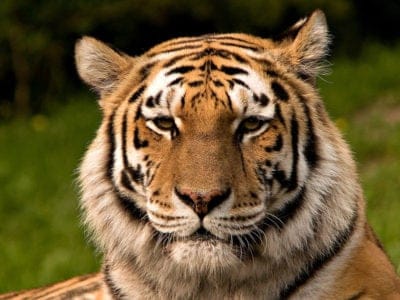
Siberian Tiger
Also known as the Amur tiger!

Siberian Husky
Is adequately warm in sub-zero temperatures!
Newest Animals that Start with the Letter T
The most recently added Animals that start with the letter T.

Tokay Gecko
The Tokay gecko gets its onomatopoeic name from its "To-kay!" barking call.
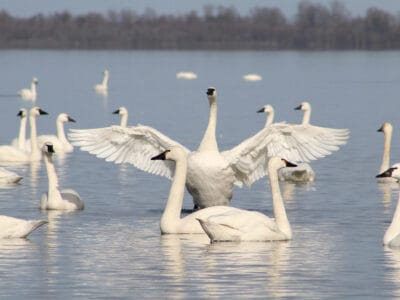
Tundra Swan
“The tundra swan is entirely white except for a yellow marking at the base of their bill!”
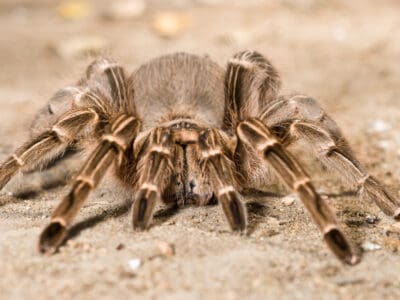
Tarantula
More than 1000 species of tarantulas have been identified all around the world!

Animal by Letter Lists
- Animals that Start with A
- Animals that Start with B
- Animals that Start with C
- Animals that Start with D
- Animals that Start with E
- Animals that Start with F
- Animals that Start with G
- Animals that Start with H
- Animals that Start with I
- Animals that Start with J
- Animals that Start with K
- Animals that Start with L
- Animals that Start with M
- Animals that Start with N
- Animals that Start with O
- Animals that Start with P
- Animals that Start with Q
- Animals that Start with R
- Animals that Start with S
- Animals that Start with T
- Animals that Start with U
- Animals that Start with V
- Animals that Start with W
- Animals that Start with X
- Animals that Start with Y
- Animals that Start with Z
Thank you for reading! Have some feedback for us? Contact the AZ Animals editorial team.



